

PO Box 9021, Wilmington, DE 19809, USA
E-mail: font@focusonnature.com
Phone: Toll-free in USA 1-888-721-3555
or 302/529-1876
HIghlighTS
from some past
Focus On Nature Tours
in
JAPAN
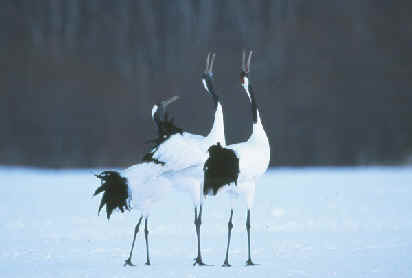
In the following summaries, there are further links to LISTS of BIRDS and OTHER
WILDLIFE
January/February 2014 - Winter Birding: Honshu, Hokkaido, Kyushu, Amami
October/November 2013 - Fall Birding: Honshu & Hokkaido
January 2011 - Winter Birding: Honshu, Hokkaido & Kyushu
May 2010 - Spring Birding: Honshu, including Hegura Island
January
2010 - Winter Birding: Hokkaido & Honshu
July
2009 - Summer Birding & a Total Solar Eclipse: Honshu, Okinawa, Amami,
Kyushu
January/February 2009 - Winter Birding: Hokkaido & Honshu
January 2008 - Winter Birding: Honshu, Hokkaido, & Kyushu
December 2007 - Late-Fall Birding: Honshu, Kyushu, & Hokkaido
May 2007 - Spring Birding: Honshu, including Hegura Island, Okinawa, Amami, Kyushu
January 2007 - Winter Birding: Honshu, Hokkaido, Kyushu, and Amami
May 2006 - Spring Birding: Honshu, including Hegura Island
May 2005- Spring Birding: Honshu, including Hegura Island, Amami, Okinawa, and Kyushu
January/February 2005 - Winter Birding: Honshu, Hokkaido, Kyushu, and Amami & Okinawa
December
2004 - Winter Birding: Honshu, Hokkaido, Kyushu, and Amami
May
2004 - Spring Birding in Central Japan: Honshu, including Hegura Island
January 2004 - Winter Birding: Honshu, Hokkaido, & Kyushu
January 2003 - Winter Birding: Honshu, Hokkaido, Kyushu, and Amami & Okinawa
May 2002 - Spring Birding in Central Japan: Honshu, including Hegura Island
May 2002 - Spring Birding in Southern Japan: Nansei Shoto (including Okinawa & Amami) and Kyushu
April
2001 - Spring Birding in Central Japan: Honshu, including Hegura Island
In the FONT Archives:
Some Photos of People, Places, & More during Previous FONT Tours in
Japan
In all,
there have been 37 FONT birding & nature tours in Japan.
![]()
General Japan
Links:
Upcoming FONT Japan Birding & Nature Tours
A
List & Photo Gallery of the Birds of Japan, in 2 parts:
Part #1: Pheasants to Pitta Part #2: Minivets to Buntings
Birds during FONT Tours on the Japanese islands of:
Honshu
Hokkaido Hegura
Amami
Okinawa
Rare Birds during FONT Tours in Japan (with some photos)
Butterflies
of Japan (with
some photos)
![]()
JAPAN
WINTER BIRDING TOUR (Honshu. Hokkaido, Kyushu, Amami)
January/February 2014
The FONT
Japan Winter Birding & Nature Tour in January
& February 2014 was our 37th tour in that country and our 24th
there during the fall & winter seasons.
During our tour, 145 species of birds were found, as we travelled on 4 Japanese
islands: Honshu, Hokkaido, Kyushu,
and Amami.
The northernmost of those islands, Hokkaido,
was, as it always is during January & February,
the most wintry, with snow and cold temperatures.
But also, again, as has been the norm during this tour, there were, in the
setting there of spectacular scenery, some special birds including dozens of
both Steller's Sea Eagles and White-tailed Eagles along the
seacoast, Red-crowned Cranes in a flock as they called and danced on the
snow, and Whooper Swans also calling as they were on the open water of an
otherwise frozen lake.
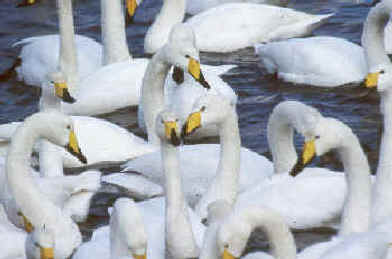
Whooper Swans in Hokkaido
(photo by Alan Brady, during a previous
tour)
This tour was dedicated to our good friend
Alan.
He passed away the day before it began.
Elsewhere on Hokkaido, at a place with a hot spring and Japanese bath, by a
fast-flowing stream in a snowy woods, a little wren walked at the water's
edge. Also there, a very attractive animal, a mostly orange-colored Japanese
Marten was in view as the big Blakiston's Fish Owl repeated its deep
call, at dusk, from up in the trees.
While on the more southerly island of Kyushu, we saw
Saunder's Gulls and
Black-faced Spoonbills along the coast. Both are rare birds, and both come from
mainland Asia, visiting Japan in the winter.
The Saunder's Gull comes from
China; the Black-faced Spoonbill most likely from Korea.
The next day, in reeds, two other species that are nice to see were enjoyed, the
Chinese Penduline Tit and the Pallas' Reed Bunting.
Not far from them, were flocks of thousands of White-naped and Hooded
Cranes.
Among nearby Rooks, there was the Daurian Jackdaw.
All these species also come from mainland Asia, to be in Japan in the
winter,
We had come, of course, to be in Japan in the winter, but we came from places
even further away. Some in our group came from Holland, some from England, while
one of us (me) came, of course, from the eastern US.
Another bird came to Japan from mainland Asia with the adjective "Daurian"
in its name.
The male Daurian Redstart was one of the most attractive of the
smaller birds during our tour.
Rare in Japan on Kyushu was a species more likely to be in mainland Asia, the
Forest Wagtail.
The Japanese name for that bird is "Iwani-sekirei" which means
"sideways-swinging wagtail", and is that what bird does.
Photographers had set food for it on two stumps, with a horizontal stick in
between. The bird came in, and walked back and forth on that stick with its
distinctive swaggering, sideways-swinging walk.
As it was on on one of the two stumps, an attractive male Daurian Redstart was
on the other.
The Forest Wagtail was a first for FONT tours in Japan, making 397 species
cumulatively found during our 37 tours.
On the southernmost island during our tour, Amami,
we had very nice looks at one of the endemic and specialty birds, the Amami,
or Lidth's Jay. That bird is endemic not only to Japan, but actually to
Amami and one small adjacent island.
Considered subtropical, Amami is a green island, with forested hills.
During our stay there, other birds that we we encountered included 3 species of owls,
the Black Wood Pigeon, the Ryukyu Robin, a single Solitary
Snipe (not to be redundant), 4 species of plovers on a single beach
where offshore a Brown Booby flew, Pacific Reef Herons on seaside
rocks, and both the Amami and the White's Ground Thrushes.
Ending the tour, a beautiful little turquoise jewel sat streamside, a Common
Kingfisher. No matter how common, it's always a nice bird to see - and were
many of the birds during our January-February 2014
Japan Tour.
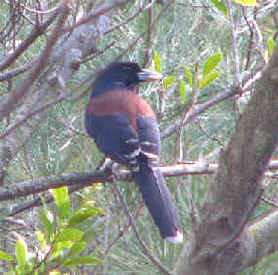
An Amami, or Lidth's Jay,
photographed during a previous FONT tour.

The Common Kingfisher
Links:
More about the FONT Japan Tour in January-February 2014
Birds & Other Wildlife during FONT Japan Tour in January-February 2014
![]()
JAPAN
FALL BIRDING TOUR (Honshu, Hokkaido)
October/November 2013
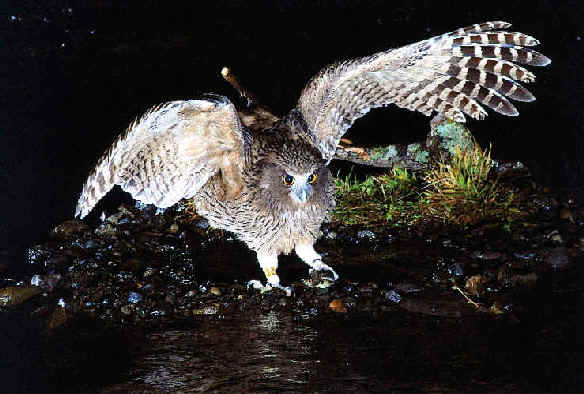
The Blakiston's Fish Owl as we
saw it during our Japan tour in November 2013
Our FONT
2013 autumn tour in Japan was filled with things to be remembered,
and among the most memorable were big, rare Blakiston's Fish Owls, close
to us at a stream (we saw 3), and stately Red-crowned, or Japanese
Cranes, known as "Tanchos" out on fields, so nice
to see as they walked about. These owls and cranes were on the
northern Japanese island of Hokkaido.
On the main Japanese island of Honshu, never
to be forgotten were the brilliant colors of the trees in the mountains.
Beneath fresh snow on peaks up to about 10,000 feet above sea-level, the fall
foliage was an incredible profusion of reds, oranges, and yellows. The
forests on the slopes were ablaze with color.
In that marvelously scenic area called the "Japanese
Alps", we rode a gondola to be as high as we could be.
Then, getting away on a trail, from the others who had taken the same ride, we were
in a wonderful forest of conifers, where we looked eye-to-eye with a bird
endemic to Japan, the Japanese
Accentor, and later a Spotted Nutcracker perched nearby on a treetop.
At the classy Japanese inn where we stayed, nestled among snow-topped mountains
and surrounded by the incredible bright foliage, and where we ate and slept
"Japanese-style", there were, in the morning, outside the door, more nutcrackers
and a large flock of Bramblings that had just arrived from further
north.
A gondola was just one of many ways we traveled during the tour. We were,
on the ground, in four different hybrid vehicles, a couple taxis,
a skinkansen (or "bullet train"), while in the air, we
were in a plane from Honshu to Hokkaido, and at sea on a large ferry,
going overnight from Hokkaido back to Honshu. During our morning on that big
boat, after the sun rose in the "land of the
rising sun", as Japan is called, we saw seabirds all
morning, with thousands of Streaked Shearwaters and other pelagic birds
including 2 species of Albatrosses, the Black-footed and the Laysan,
along with jaegers and gulls. Among the latter, there were kittiwakes.
We saw two pods of Pacific White-sided Dolphins swimming quickly in the
water. As rapid, or even more so apparently, were the Pacific Blue-finned
Tuna being chased by the dolphins. One big tuna leaped completely out of the
water.
Mammals seen on land during our October-November
FONT Japan Tour included Red Fox, Sika Deer, Raccoon Dogs
(3 of them seen well), and the Japanese Macaque, or "Snow
Monkey".
Butterflies during our autumn tour in Japan, even as late as the end of
October and early November, included: Nepargynnis anadyomene (a fritillary),
Polygonia c-album hamigera, the race in Japan of the Eurasian Comma,
Goenpteryx aspasia, the Common Brimstone, and Pieris
brassicae, the Large White. The last of these, a close
relative of Pieris rapae that we know in the US as the Cabbage White,
was seen along the seacoast of the northern island of Hokkaido, even as late as
in November.
In all, we found 122 species of birds on Honshu
and Hokkaido during our October-November
2013 tour in Japan, during which
there were also innumerable "Japanese experiences" for us,
including:
sushi, tea, various footwear, onsens (hot springs), ryokans
(Japanese inns), temples, rice fields, bonsai, and the gardens
where we saw some of our birds.
Near where we saw the Red-crowned Cranes, a young Japanese lady gave us
an "origami", a small paper replica of yes, the crane.
It was just one of the nice moments during our tour.
Links:
More about the FONT Japan Tour in October-November 2013
Birds & Other Wildlife during FONT Japan Tour in October-November 2013
![]()
JAPAN
WINTER BIRDING TOUR (Honshu, Hokkaido, & Kyushu)
January 2011
The FONT
Japan Winter Birding & Nature Tour in January
2011 was our 35th tour
in that country. During that tour, we visited the 3 Japanese islands of
Honshu, Hokkaido, and Kyushu.
In all, 125 species of birds were found: 76 on Honshu, 66 on Kyushu, and 49
on Hokkaido.
Although in Hokkaido
there was the lowest number of bird species, it was that
island, again, with the most highlights, including cranes, eagles, and
the Blakiston's Fish Owl.
The Red-crowned Cranes were observed one nice afternoon, as they stood,
danced, and called on the snow.
At one time by the sea in eastern Hokkaido, we were surrounded by dozens
of eagles, both the White-Tailed
and magnificent Steller's, as hundreds of gulls,
mostly Glaucous, also foraged in the same area.
A fine flock of Asian
Rosy Finches was on the ground nearby.
Later as that afternoon turned to night, we saw 2 huge Blakiston's Fish
Owls. One of those big birds
flew directly over our heads.
Hokkaido also had other notable birds for us in January 2011, including a
Japanese Accentor, both Bohemian
and Japanese Waxwings, an American Wigeon among
Eurasian Wigeon, Falcated Duck, Smew, many Harlequins and other
Ducks, a flock of Lapland
Buntings or Longspurs, and some beautiful Bullfinches
of the gray-bellied race.
The Japanese Accentor is a most unusual bird in Hokkaido in the winter.
The Lapland Longspurs were a new bird for the 35 FONT Japan tours,
bringing our cumulative
total of species to 393.
In January
2011, we did pelagic trips onboard ferries
both to and from Hokkaido.
During the northbound boat-trip to Hokkaido, we saw Laysan Albatross,
numerous Kittiwakes, other gulls,
and alcids.
During the southbound boat-trip, there were Japanese Murrelet, Common
Murre, Red Phalarope, Streaked
Shearwater, Pomarine Jaeger, Northern Fulmar,
and various gulls, Pacific Loon, and Pelagic Shag.
In Kyushu
during the winter of 2010-2011, a sad note
is that bird flu struck in
the flock of thousands of cranes that come to winter from mainland
Asia. So therefore, entry was restricted to the area of those cranes,
mostly Hooded and White-naped. Even so, we saw those species
well, along with both of the other
rarer crane species there when we were there, the
Common and Sandhill Cranes.
Of course, the Common Crane is not at all common in Japan.
The Sandhill Crane
is the most common crane in the world, with most in North America, but
some breed in Asia in Siberia. In January 2011, we saw 3 Sandhill Cranes
in Kyushu.
The Hooded is the most
common of Kyushu's Cranes, with generally about 9,000.
The White-naped Crane is beautiful bird, graceful for sure. Generally
from about 1,500 to 2,000 of them winter on Kyushu.
Before we arrived in Japan,
about a half-dozen Hooded Cranes and a White-naped
Crane had died from the bird flu. Both species are classified as
"vulnerable", even without the flu problem, so let's hope that their
situation relating to that
disease improves.
The cranes leave their limited wintering range in Japan in February to
return to their expansive breeding
range in China and Russia.
Other birds that we saw in Kyushu included, in reeds, the rare Pallas's 'Reed Bunting from Asia along with the Common Reed Bunting, which is common, as well as a White's Ground Thrush foraging in leaf litter, and a large flock of Common Shelducks, common at least at that one place.
Other notables during the tour were Mandarin Ducks, always nice to see, as were Japanese Grosbeaks, Hawfinches, Common Kingfisher, Brown Dipper, Azure-winged Magpie, the Japanese Green Woodpecker, Varied Tit, Red-flanked Bluetails, and Daurian Redstarts. As noted earlier, 125 bird species in all.
There were 7 species of mammals
during the tour including: the Japanese Macaque
(or Snow Monkey), Red Fox, Sika Deer, Northern Fur Seal, Kurile
Seal, and, again for us, a
second time, Sea Otter. Our other time for that rare animal
in Japan was the previous January, in
2010.
In Hokkaido, where we found our least number of bird species, there was for
us the most species of mammals.
And of course, as already said,
it was in Hokkaido where we experienced the true
avian highlights, including the cranes, swans and ducks, alcids,
eagles, and what is said to
be the largest and rarest owl in the world.
Link:
Birds & Other Wildlife during FONT Japan Tour in January 2011
![]()
JAPAN SPRING
BIRDING TOUR (Honshu including Hegura Island)
May 2010
Our spring tour in Japan in
May
2010 was the 34th FONT tour in that country, and the 7th to include
Hegura, a
small island in the Sea of Japan that is an outstanding place for bird migration
in the spring - one of the best such places anywhere in the world.
Other places that were visited on the main Japanese island of Honshu included
the Japan Alps, the rural Noto
Peninsula, and forested
hills in central Honshu and reed beds and rice fields in the eastern
part of the island.
Links:
More about the FONT Japan Tour in May 2010
Birds & Other Wildlife during our Japan Spring Tour - May 2010
Birds during FONT tours on Hegura Island (with some photos)
![]()
JAPAN WINTER BIRDING TOUR (Hokkaido & Honshu)
January 2010
The 33rd FONT
birding & nature tour in Japan took
place in January 2010. During that tour, a
wild creature was seen for the first time during any of our tours in Japan. On
the northernmost Japanese island of Hokkaido,
at the easternmost place in Japan, seen from shore were 2 Sea Otters. At
another place in eastern Hokkaido, late that same day, as many as 1,000 Sika
Deer were seen.
And these in that part of Japan were in addition to the avian cast of characters
that we've always enjoyed seeing, the eagles, both Steller's Sea
Eagles and White-tailed Eagles, both seen closely, and the cranes,
the Red-crowned, or Japanese, Crane, that were again as stately as
they've always been for us, on the snow.
Among the numerous waterfowl that we saw during the tour were 2 species
of swans, 2 species of geese, and numerous ducks. Notably
beautiful among the last of these were the Mandarin, Falcated, Long-tailed,
and Harlequin Ducks, and Smew. Of each of these, we had wonderful
sightings.
Other interesting and enjoyable sightings during the tour included: Japanese
Macaques (or "Snow Monkeys"), Pallas'
Rosefinch, Red-flanked Bluetail, and many Daurian Redstarts and Brown
Dippers.
Links:
Birds & Other Wildlife during FONT Japan Tour in January 2010

During the FONT Japan Tour in
January 2010,
2 Sea Otters, known as Rakkos, were seen
from shore in eastern Hokkaido.
The Sea Otter is very rare in Japan.
Only 2 or 3 dozen are said to exist
in the nearby islands that are part of Russia.
![]()
JAPAN SUMMER BIRDING & A TOTAL SOLAR ECLIPSE
(Honshu, Okinawa, Amami,
Kyushu)
July 2009
It took place
during the Summer of 2009, specifically July
12-26: our the 32nd FONT birding & nature tour in
Japan,
which was our 8th FONT tour, since 1991, with an eclipse of the Sun,
and our 5th tour with a total solar eclipse.
Previous total solar eclipses during FONT tours were in:
Costa Rica in July
1991,
Bolivia in November
1994,
Venezuela in February
1998,
and Turkey in August
1999.
We've seen annular solar eclipses during our tours in Iceland
in May 2003 and in Spain
in October 2005.
A partial solar eclipse took place during a FONT tour in Guatemala
in April 2005.
At the north end of
the southern Japanese island of Amami, we
experienced the total eclipse of the Sun on July
22, 2009. Our vantage point was at the tip of a cape by the Pacific
Ocean. During the eclipse, some of the people in our group took a dip in the
nearby ocean water, as overhead the disk of the Sun could be seen shrinking and
the sky's light was fading.
The Sun, at the totality of the eclipse, was high in the sky. The nearly 4
minutes of totality, where we were, was at about 11:00am.
Unfortunately, also in the sky above us were clouds. There was a thin layer of
them during most of the eclipse prior to totality, as well as during the nearly
4 minutes when darkness fell.
So, even though we could not see some of the features of a total eclipse that we
would have if the sky were cloudless, there certainly was an experience to be
had.
To the north of us, where totality was longer, we learned later that the clouds
were thicker (so thick that the eclipse overhead in the sky could not be seen at
all). Along the center line, to our north, totality was about 2 minutes longer,
making it just over 6 minutes, and giving this eclipse the longest period of
totality of any during the entire 21st Century.
During the nearly 4 minutes of darkness where we were, there was a fascinating
pattern of clouds in our sky. Truly ominous they appeared. A short distance
away, during the mid-day darkness, the beacon of a lighthouse on rocks above the
sea shone as it would at night.
The Pacific Swallows, by the Pacific Ocean, during dark totality stopped
flying. They actively flew about us during most of the eclipse. A Pacific
Reef Heron flew along the water's edge of the Pacific, also during the
eclipse, as did some Roseate Terns.
Overall, birds that day at that cape at the north end of Amami Island were not
plentiful, but people were. Nicely, though, it was not crowded where we were, at
our good vantage point, but as we looked about, especially behind us, we could
see that we were but a few of the many who had come to experience the event.
Mostly, those who came were Japanese.
It was the first total solar eclipse in Japan in many years, and so considerable
publicity and anticipation preceded it. From the heavily populated Japanese
islands to the north, many came to the relatively small, and usually not often
visited, Amami Island, coming over a period of days by plane or by ferry. (We
did the latter, from Okinawa.)
They filled the few hotels on Amami, but many who came for the eclipse camped in
tents at the north end of the island. We spent our nights on Amami in hotels (2
of them), but when we looked to our right, from our vantage point, we saw
many of the tents in the dark shadow of the eclipse. Turning to our left, we saw
the open water of the Pacific Ocean, while overhead there was, that morning, the
sun, the moon in front of it, and the clouds.
During our minutes of totality, to the south there was a brighter sky toward the
horizon, where a few miles away, in that direction, the shadow of totality did
not occur.
Just about 2 hours after the eclipse, as we were going south from the totality
zone toward town (to Naze, the largest city, and actually the only city on
Amami), rain poured down from the clouds that by then had thickened. Earlier
that day, by comparison, we had been fortunate to have had the eclipse
experience that we did.
The Japanese island of Amami, with or
without an eclipse, is a wonderful place. We've visited it many times, with over
15 FONT tours there. With mostly forested hills, it's a "green island"
with some wildlife nearly all its own. There are birds endemic to the island or
nearly so.
During our July 2009 tour, birds in those categories that we were treated to
included the colorful Lidth's Jay, the nocturnal Amami Woodcock,
and the very rare Amami Thrush.
In all, 139 species of birds have cumulatively been found during FONT tours in
Amami. In July '09, we added 5 to that list: Cinnamon Bittern, Ruddy-breasted
Crake, Watercock, Black-winged Stilt, and Wood Sandpiper. They were
all found during an enjoyable couple morning hours in an area of fields and rice
paddies.
The Black-necked Stilt is a rarity in Amami.
The Watercock was not only new for us in Amami - it was a new bird for
FONT tours in Japan, bringing the cumulative tally of birds in Japan during FONT
tours to 390 species.
Other notable birds during our July 2009 Japan tour included the extremely rare Okinawa
Woodpecker, the Okinawa Rail (that became known to science
only as recently as 1982), Black-naped Terns, and a Terek
Sandpiper.
Our views of Ruddy Kingfishers were sometimes brief, but we always liked
hearing their distinctive, rollicking calls, as we did frequently.
In addition to the birds that we either heard or saw during our tour in Japan in
July 2009, we also enjoyed a tremendous number and variety of butterflies
and dragonflies.
And there were some mammals too - including Wild Boar, Sika Deer, and a
quick glimpse of the odd nocturnal creature known as the Amami Rabbit.
It's endemic to that island.
With the eclipse, the variety of nature, and the native culture and cuisine of
that out-of-the-way part of Japan, our July '09 tour in Okinawa,
Amami, Kyushu, and a bit of Honshu,
was a memorable one.
Links:
More
about the FONT Japan Tour in July 2009
Birds & Other Wildlife during the FONT Japan Tour - July 2009
Solar Eclipses & Other Celestial Nature during FONT Tours
![]()
JAPAN WINTER BIRDING TOUR (Hokkaido & Honshu)
January/February 2009
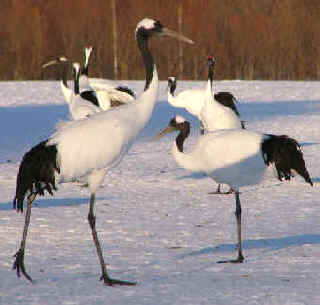
The word in
Japanese for the Crane is "Tancho".
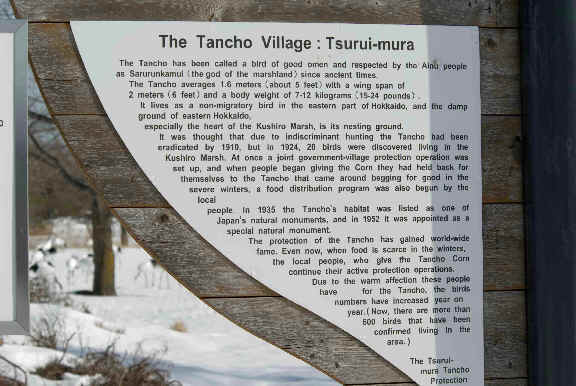
Links:
Birds & Other Wildlife during FONT Japan Tour in January-February 2009
The following account was written by Armas Hill, leader of the tour:
Of course, during
our winter tours in Japan, particularly in Hokkaido,
birds that are highlights are those such as the dancing and calling Red-crowned,
or Japanese, Cranes, the gatherings of Steller's and White-tailed
Eagles, the flocks of Whooper Swans, and the large & rare
Blakiston's Fish Owl.
All of those we experienced again during our Jan/Feb
2009 Japan Tour in Hokkaido. In
fact, that tour was the 20th FONT birding & nature tour in Japan during
which we've seen the Blakiston's Fish Owl. (We've never missed!)
But, during the tour, there were other birds too - a number of them, including
some not as well known outside Japan, such as the Brown-eared Bulbul and Olive-backed
Pipit, in photographs below taken during the tour. The Brown-eared Bulbul
is nearly endemic to Japan.
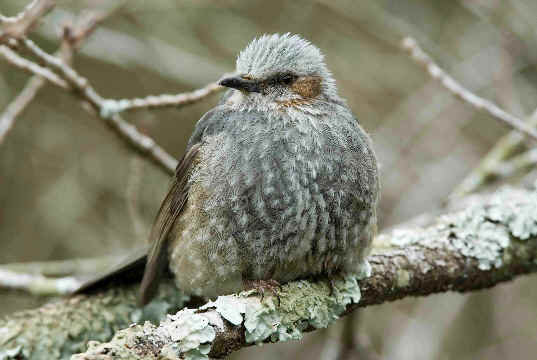
Brown-eared Bulbul,
photographed during the FONT
January/February 2009 Tour in Japan
(photo by Karl Frafjord, of Norway)

Olive-backed Pipit, photographed during the
FONT
January/February 2009 Tour in Japan
(photo by Karl Frafjord, of Norway)
![]()
Japan
Winter Birding Tour (Honshu, Hokkaido, Kyushu, &
Amami)
January
2007
Link:
Birds
& Other Wildlife during our Japan Winter Tour - January '07
During this, our January
15-30, 2007 Japan Winter Birding Tour, which was the 27th FONT birding
& nature tour in Japan, and the 17th such tour in the winter, among the
highlights, as always, were the cranes and the eagles.
During this tour, there
were 5 species of Cranes (Red-crowned, White-naped, Hooded, Common,
& Sandhill), and large numbers of both Steller's Sea-Eagles
and White-tailed Eagles were observed.
And once again, as during every
FONT Japan tour in the winter, we saw the big & rare Blakiston's Fish-Owl.
Other notable bird species during the tour included: Copper Pheasant,
Solitary Snipe, Black-faced Spoonbill, Spectacled Guillemot, Long-billed
Murrelet & other alcids, Laysan Albatross, Mandarin Duck, and Hodgson's
Hawk-Eagle.
During the tour the 3 main Japanese islands of Honshu,
Hokkaido,
and Kyushu were visited. Lastly we went to the smaller island of
Amami, where we
saw the bird specialties (endemic or nearly-so) including: the Amami
Woodcock, Amami Thrush, Lidth's Jay, and Ryukyu Robin.
During this
tour Japanese Macaques (or "Snow Monkeys") were seen on
2 islands, Honshu & Kyushu.
The above paragraphs put in capsule form some highlights of the tour. A more
descriptive narrative follows:
All of our Japan tours begin on the main Japanese island of Honshu. That's
because the Narita International Airport, northeast of Tokyo, is the major
gateway into the country. And so it's good fortune that the birding on Honshu
can be extraordinarily good, no matter what season we are there. It's because
Honshu is a large island, and with varied topography. There are open flat
lowlands and there are forested mountainous highlands. Yes, there are people,
many of them. But it's interesting that, throughout Japan, 80 per cent of those
people live on 20 per cent of the land. And so, it's surprising to many who have
traveled in Japan with us, over nearly 20 years, that one doesn't really have to
go far from Tokyo (or Narita) to find countryside where there's nature and some
good birding.
During our 2007 Japan Winter Birding Tour, after we arrived on Honshu, we went first to some open, flat lowlands, not very far from Narita. In
a river valley, with islands with agricultural fields and areas of reed-beds, we
saw a nice number of 2 species of Harriers (the Eastern Marsh, and the
Northern,
or Hen) hunting over the fields. In the reeds, we found 2 species of aptly-named
Reed Buntings (the Common and the Japanese). The second of these we normally
find in that area during our tours in the spring. It was warm that January day,
seemingly almost as warm as when we visit in May. A Ruddy-breasted Crake was
heard calling in the reeds.
We traveled downriver a bit to where it meets the ocean, and where there's a
large fishing port. The riverbanks there are literally covered with birds. There
are many cormorants and ducks, and almost more gulls than can be imagined. When
we there in the afternoon, the fishing boats were coming into port. Above the
dozens of boats with their catches, there were swarms of gulls, thousands of
them - in the sky, on the water, on the ground, on roofs, everywhere. Even for
those not as fond of gulls as they are of other birds, it was a spectacle to
behold with much to observe as there were 8 species of Gulls in an assortment
of plumages: Common Black-headed, Black-tailed, Kamchatka (or Mew),
Vega
(formerly Herring), Slaty-backed, Glaucous-winged, Glaucous, and Black-legged
Kittiwake.
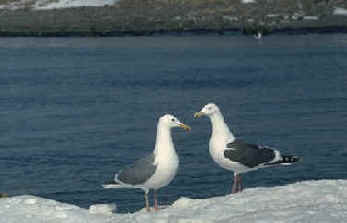
Just two of many gulls
along the Japanese coast.
Vega Gull (left) & Slaty-backed Gull (right)
Some Japanese birders were looking for
Thayer's Gull (at a
traditional spot for it). They hadn't found it when we spoke with them (in a
little English and a little Japanese), but they did tell us of a Black-faced
Spoonbill on the other side of the river. We thanked them and went to the
said-spot hoping to see the rare bird. And that we did. The Black-faced
Spoonbill is one of the rarest birds in the world. It's total population is said
to be under 700 birds that breed locally in Korea and China. Every year some
winter in Japan, usually in the southern part of country. We've seen it during
our winter tours previously in Kyushu, Okinawa, and Amami (1 bird once on the
last of these). This was the first time (in 17 winter tours) that we saw the
bird in Honshu.
Our afternoon at the fishing port ended by a sheltered cove, where we watched
grebes and cormorants fishing in the clear water beneath us. The Cormorants were
the Japanese (or Temminck's). The Grebes were of 3 species:
Great Crested, Red-necked, and Horned. The small fish in the water there were plentiful. Oh
yes, there were ducks there, too. Ducks, of a number of species, are also
plentiful in the winter in Japan.
The next day we were in a completely different world. We were still on Honshu,
but we had driven just over 2 hours to an area of forested hills. We spent the
night in wonderful little hotel in the forest, with a Japanese hot bath (or
onsen). As the day began, outside the window as we had breakfast, birds were at
the feeders. Some light snow was falling. It was, simply put, a beautiful setting
(and, as noted, one almost wouldn't believe that in this woods we were just a
short drive from the sprawl of Tokyo). Among the birds at the feeders, there
were a number of Japanese Grosbeaks and some Varied Tits. Stepping outside, when
we'd put seeds into the palms, the Varied Tits would land on our hands to have
their breakfast.
At another feeding station nearby, with not only feeders with seed and suet,
there was some open water, much like a spring. There we were treated to good
looks of the endemic Japanese Accentor, the Northern (or Winter)
Wren, and the
Yellow-throated Bunting by the water, in addition to the regular cast of
characters including an assortment of tits, nuthatch, woodpeckers, and finches.
Between the two sets of feeders, out in the woods, a stream with open water
flowed where otherwise there was snow on the ground and the trees were bare.
From along the edge of that stream, a Solitary Snipe flew up into the sky. That
species winters at such spots in the forested hills of Japan. Alone, as it is,
after all, the Solitary Snipe. This one bird was the first for us (again, in 17
tours in the winter). The species is not in Japan outside the winter, as it
breeds in places such as Siberia and Manchuria, not alone but only in pairs
spread out with nests in remote locations. Ours was a nice bird to see. In the
stream itself, there were Brown Dippers in the water, also nice to see. The
Brown Dipper of eastern Asia, Cinclus pallasii, is named after Peter Simon
Pallas, who lived from 1741 to 1811. He was the most eminent explorer-naturalist
of his day. One of his journeys was a 6-year expedition (1768-74) across Russia,
east from St, Petersburg to Lake Baikal and beyond. One can wonder if he ever
encountered the Solitary Snipe where it breeds in that remote region
"beyond".
During our time in hilly, central Honshu, there were a couple other notable
sightings. Late in the afternoon, as it was getting a bit foggy, a Ural Owl flew
in front of us as traveled along a road. It was seen nicely, but it would been
good if we could have found nearby perched in a tree.
The next morning, when there was a bright blue sky, the treelimbs in the forest were
covered with a layer of snow. It was a beautiful morning, which could have been
better with just one thing. We were trying, before we had to leave the area, to
see a bird that's always at or near the top of the "most-wanted list"
for most birders visiting Japan. The bird: the endemic Copper Pheasant. On the
fresh snow, at the edge of a side-road, we saw fresh tracks. And, then, shortly
later, near that spot, it was as good as it gets when a male Copper Pheasant
walked out in front of us, as we sat in our vehicle. For a while, the bird stood
still, and thus, we got a long look at that exquisite bird with the long tail!
Yes. it was as good as it gets.
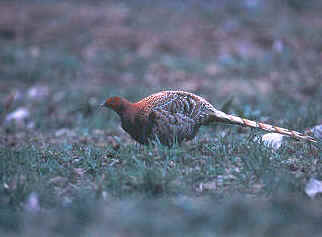
A male Copper Pheasant
The birds noted so far (after the first paragraph) were all on Honshu, where,
yes, as it's been said, the birding can be "extraordinarily good".
But, really, during our Japan Winter Tours, it's the birds of Hokkaido and
Kyushu
that normally get the top-billing - the cranes, the eagles, and the
Blakiston's Fish-Owl.
To go from Honshu to Hokkaido, we have, over the years, taken an overnight ferry
as a pelagic trip on the Pacific. And that we did again in January '07. The
ferry is a large boat, on which after boarding we sleep, and then all-day
offshore we can scan the sea for birds. We were this time as the boat has a
good, big enclosed area in the front end of the boat, from which we could see
the sea ahead of us.
In recent years, for whatever reason, we have not been seeing, during this trip,
as many Laysan Albatrosses as we did in the past. In '07, however, that trend
was reversed. Maybe it was because we could watch ahead of us continuously in
comfort, but this time we saw about 50 Laysan Albatrosses flying in their
distinctive style above the water.
And having the good area for observation certainly enabled us to see alcids
better than usual (as it's always better to observe them in front of the boat).
From our vantage point on the ferry, as we headed north, offshore from Honshu,
and continuing into colder waters, the alcids we saw were: Common Murre,
Thick-billed Murre, Spectacled Guillemot, Pigeon Guillemot, Long-billed Murrelet,
Ancient Murrelet, and Least Auklet. Most of these we saw in rather large
numbers.
Hokkaido in January is a land of winter. It always has been for us, although
January 2007 was warmer than usual. From eastern Hokkaido, there's a boat-trip
that goes to the edge of the oceanic ice. It's a good way to see more alcids
(which we did) on the water, while on the ice, Steller's Sea-Eagles and possibly
other interesting birds can be seen. This year, the ice was too far from shore,
so 1) the boat didn't go to it, 2) the trip cost a little less, but 3) we did
see alcids again nicely on the water, particularly with good looks of the
Spectacled Guillemot, a species that's rather restricted to the Sea of Okhotsk
and comparable waters of northeast Asia.
Back onshore, along the eastern coast of Hokkaido, we were treated to flocks of
colorful Harlequin Ducks, other Ducks including Falcated, Glaucous Gulls
(usually very common in eastern Hokkaido), an Iceland Gull (rare in Japan), a
Gyrfalcon that caused a swarm of gulls to fly into the air as it flew by, and
the stars of the show, the Eagles - one of those stars is even called "Steller".
Both the Steller's Sea-Eagles and the White-tailed Eagles were seen nicely and
in good numbers during our tour.
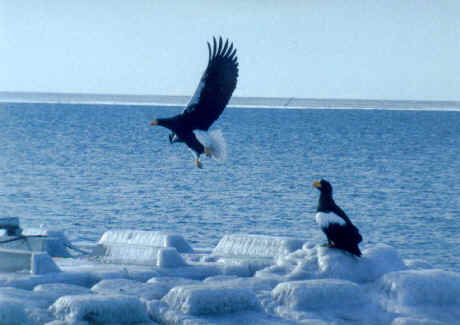
Steller's Sea-Eagles in
eastern Hokkaido
In January '07, along the eastern Hokkaido coast, we saw a small and colorful
bird that we don't normally see on Hokkaido in the winter: a male Daurian
Redstart. Usually we see it further south. So, this time, we saw this species
that only winters in Japan, on all 4 of the islands that we visited (north to
south: Hokkaido, Honshu, Kyushu, and Amami).
During all of our 16 previous Winter Japan Birding Tours, we've seen the
Blakiston's Fish-Owl. Localized in Japan only in Hokkaido, it is one of the
world's rarest owls. (Occurring also in the wilderness of eastern Siberia, it's
far from plentiful there also - in that land where the Siberian Tiger lives.)
It's exciting to see the Blakiston's not only because it's rare, but also
because it's huge, being one of the largest of the world's owls. At dusk, we
were at the right spot. We heard first the deep call of the bird. Then, with
their large wingspans, two of them flew in to perch in trees near us! For FONT,
it was the Blakiston's Fish-Owl for the 17th time.
In the town where we spent a couple nights in eastern Hokkaido, there are some
shops where local people sell woodcarvings that they've made of the
Blakiston's Fish-Owl. After seeing the owl in life, it was nice to see (and buy)
the woodwork in the store. Being in Hokkaido is such a great experience, so far
away from the world in which most of us live.
Down the road, from the town with the shops, the Hokkaido experience is
reinforced in the morning, as Whooper Swans swim and call enshrouded by mist in
the waters of a big lake. Those noisy Whoopers are only in Hokkaido during the
winter. When Hokkaido warms up, they go north to Siberia, where they breed.
The Red-crowned Cranes in Hokkaido, also vocal, are there, however, throughout
the year. They don't leave. In the winter, however, they flock up together at
certain places, where watching them is one of a birder's highlights of a
lifetime. Also known as Japanese Cranes, these tall stately birds can be seen in
the winter, against a beautiful snowy background, jumping into the air, and can
be heard making their bugle-like sounds. In the first half of the 20th Century,
that sound nearly became silenced when the species in Japan flirted with
extinction. It was nearly as rare as the Whooping Crane of North America. How
great it is that both species were not lost, when really they very well could
have been. Today, there are about 900 Red-crowned (or Japanese) Cranes in
Hokkaido (the only place in Japan where they occur). We saw at one place more
than 200 of
them.

Red-crowned (or Japanese)
Crane
Seeing the cranes in Japan is of course a wonderful experience, but it can
enhanced by the reading of a book, published not that long ago in 2001,
"The Birds of Heaven - Travels with Cranes", by Peter Matthiessen.
There's a chapter in that well-written book about the Red-crowned Cranes in
Hokkaido.
As good as it is that now there are nearly a thousand cranes in Hokkaido, in
Kyushu during the winter, there are about 7,000. They come to one particular
area there every year from mainland Asia, where in the summer their nesting area
is spread across many miles of mostly Siberia. In the winter, however, they come
to be together in a large grouping of about 5,000 Hooded Cranes and 2,000
White-naped Cranes. Adults and young of the year are seen together, among the large
flocks.
For years, we've come, from other parts of the world, to see these birds. Again,
as with the cranes on Hokkaido, it's quite an experience. Every year, a few
cranes of other species are also in the flocks. Every year, we've seen Common
Cranes and Sandhill Cranes, as we did again in January '07. Some years, there
have been Siberian Crane and Demoiselle Crane. During the 2006-07 winter, birds
of those 2 species were not in
Japan.
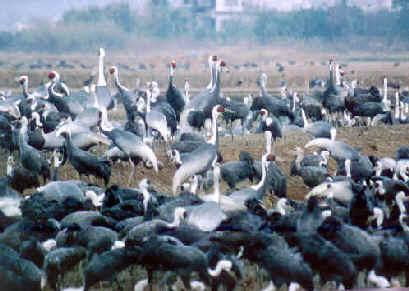
Hooded & White-naped
Cranes in Kyushu
Cranes are not the only birds that come to Kyushu, Japan from mainland Asia to
spend the winter. Not far from the cranes, we saw some small birds in the reeds
that did the same thing: Chinese Penduline Tits and Pallas's Reed Bunting
(another Asian bird named after Peter Simon Pallas). Having done the same type
of journey were the Daurian Jackdaws that we saw mixed in among the Rooks
(also
from mainland Asia) on the telephone wires. The Northern Lapwings and Temminck's
Stints that we saw on the fields did the same thing. They, too, are only in
Japan during the winter.
The cranes that winter in Kyushu are well-known in ornithological circles. Not
as well known, in Kyushu in the winter are the large flocks of Mandarin Ducks
present there only during that season. They are on the other side of Kyushu. We
enjoy seeing them along a particular river in a valley surrounded by forested
hills. During a day, we see at least a couple thousand of these beautiful ducks,
with different colors but otherwise similar to the Wood Duck of North America.
The Mandarins that winter in Kyushu are shy. The flocks fly up quickly from the
aqua-blue water of the river. In a telescope, and with binoculars, observing the
large number of Mandarins is yet another wonderful Japanese experience.
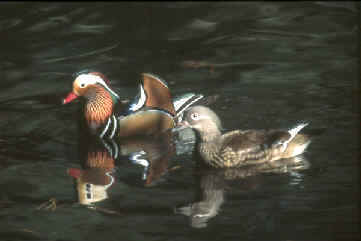
Male & female
Mandarins
In January 2007, as we were having this experience, 2 Mountain Hawk-Eagles were soaring in circles overhead above the forested hills. Not far away that day, on the ground, there were Olive Tree Pipits walking about, and a White's Ground Thrush feeding. In trees, nearby, Japanese Grosbeaks were doing the same, eating berries. By a temple, during our time in Kyushu, there was more activity in trees as Japanese Macaques, also known as "Snow Monkeys" were moving about.
We had so many wonderful experiences during our January 2007 Winter Tour in Japan.
![]()
JAPAN SPRING
BIRDING TOUR (Honshu, including
HEGURA ISLAND)
May 2006
This was the 26th FONT birding
& nature tour in Japan, the 10th in the Spring, and our 5th
to Hegura Island, a small island in
the Sea of Japan where there can be a big bird
migration.
Again, in 2006, as we have previously, we had some truly tremendous
birding on Hegura.
One day, we saw 8 species of egrets, including the rare
Chinese
(or
Swinhoe's) Egret, the Asian race of the Purple Heron, and a fine
Chinese Pond Heron in breeding plumage. At that one corner of Hegura that day,
it was like a small piece of China, as all 3 of those species are of more normal
occurrence there.
Other birds too, more common on the Asian mainland, migrate on
Hegura. In that category, we also saw the
Rufous-tailed (or Swinhoe's) Robin,
the Tristram's Bunting, and the Tricolored and Mugimaki Flycatchers.
In all, we
enjoyed 90 species of birds on Hegura Island in May 2006.
Links:
More about the FONT Japan Tour in May 2006
List of Birds & Other Wildlife during our Japan Spring Tour - May 2006
List of Birds during FONT Spring & Summer Japan Birding & Nature Tours
Upcoming FONT Birding & Tours in Japan
![]()
Japan
SPRING Birding AND NATURE Tour
(Honshu,
including Hegura Island, Amami, Okinawa, & Kyushu)
May
2005
Links:
List
of Birds & Other Wildlife during our Japan Spring Tour in 2005
The following account written by Armas Hill, leader
of the tour:

White-throated Rock
Thrush, Monticola gularis,
during FONT tour on Hegura Island, Japan, May 21, 2005.
This species is quite a rarity in Japan. It is normally on mainland Asia,
breeding mostly in Manchuria and eastern Siberia, and wintering in southern
China, and further south in Southeast Asia.
Note in this photo the white patch on the throat.
(photograph by Iwasaki Shohgo)
Other birds we saw on Hegura
Island in '05, normally found on mainland Asia, included: Mugimaki
Flycatcher (the Japanese name notwithstanding, this species does not
occur throughout Japan), Black-naped Oriole, and Hoopoe.
When we visit Hegura, during the season when birds migrate, there's also a
migration to and from the island of Japanese birders. Many of them criss-cross
the small island, with their binoculars, scopes, and cameras (often big
cameras). When an avian rarity appears, somewhere on the island, word
spreads (quickly, now often on cellular phones and pagers).
During recent years, a number of bird species that were first records for
Japan, have occurred on Hegura Island. The day before we arrived in '05, a
Japanese first had been there for two days. That bird was an attractive Rufous-bellied
Woodpecker, from China, not in any Japanese bird book. There's a notable
bird migration on Hegura in the fall also. In the autumn of 2004, two Japanese
firsts there included Common Redstart from Europe, and Gray-cheeked
Thrush from North America.
It's very interesting how the bird
migration on Hegura Island changes throughout the day. During one of
our days there, in the morning, the islands seemed to be covered with cuckoos
- in particular, at that time, Common Cuckoos. They really were common.
As we walked around the island, they were in nearly every bush. There was the
constant calling of the "Kak-ku". That's how the bird says
its name in Japanese. Nearly all of those we saw were the gray morph. But,
there was a cuckoo that we saw, of the rufous morph, that was exhausted, as it
sat on stones on the ground right in front of us! Those stones were by the
sea. The bird had apparently just come in to the island.
After lunch that day, as we walked, there were no cuckoos. But instead, flycatchers
of a few species, seemed to be "everywhere". Mostly, they were Asian
Brown Flycatchers, but also present were: Dark-sided (or Siberian),
Gray-streaked, Narcissus, and Mugimaki, and a rarity - a single Red-throated
Flycatcher, feeding on a big rock. Over all of the fields and at the pools
along the rocky shoreline, there were flycatchers sallying for insects. At the
end of the day, flycatchers were flying into the air catching bugs from nearly
all of the small pine trees on the island. As the sun set below the horizon of
the Pacific Ocean, the "green
flash"
was visible. Then, in one of those pine trees where flycatchers
perched, a Japanese Scops-Owl called.
A complete listing of the now 141 bird
species we've found on Hegura Island in the Sea of Japan is elsewhere in
this web-site.
On the southern Japanese island of Okinawa,
during our May '05 tour, we did very well with our 2 primary target-birds of
the island: the very rare Okinawa Woodpecker and the Okinawa Rail,
the latter only known to science for about 25 years. During 2 days, we saw 2
Okinawa Woodpeckers at their nests feeding young (that could be heard
calling inside the tree cavities). The species is one of the rarest
woodpeckers in the world. Though not as rare as the recently-rediscovered
Ivory-billed Woodpecker in the United States, it is an extremely rare bird
with very few breeding pairs restricted to a limited area of northern
Okinawa.
The Okinawa Rail has a similar distribution in that same limited part
of the island. By late afternoon, during our first day on Okinawa, we had seen
7 Okinawa Rails, normally a shy species hard to see. (That's why it was not
formally identified until 1981.) One of the rails was seen very well as it
stopped on a road in the forest, just in front of us, as we sat in our
also-stopped vehicle.
The string of Japanese islands, that stretch to the south of the main islands,
are known as the Ryukyus, including
Okinawa, Amami, and others smaller. That word is an also adjective for some
birds of that region that we saw during our tour: the Ryukyu Robin, the
Ryukyu Flycatcher (a resident that was formerly considered a race of
the migratory Narcissus Flycatcher), the Ryukyu
Minivet, and the Ryukyu Scops-Owl (the last of these we saw in a
puddle, apparently bathing, on a dirt road in an Amami forest, when it was
still dark just before dawn).
On a beach in Amami, one afternoon, where
from previous tours we knew that shorebirds stage in the late spring,
we saw numerous Sharp-tailed Sandpipers, and other shorebirds (or
waders) that included: Terek Sandpipers, Grey-tailed Tattlers,
Bar-tailed Godwits, Red-necked Stints, and Mongolian Plovers. The Mongolian
Plover is also known as the Lesser Sandplover. Among a flock of
them, on that beach, there was a single Greater Sandplover (a rarity
in Japan).
For more than a decade we have, during our more than 10 tours on Amami, seen,
after dark, another "shorebird of sorts" that's endemic to some of
the Ryukyu Islands, the Amami Woodcock. During the 1990's, we actually
would see quite a few, and rather easily. However, in recent years, that has
not been the case. For whatever reason, the species seems to have declined.
During our tours just prior to May '05 (in Dec '04 & Feb '05), we
were fortunate to see 1 during each tour. We've seen the species during our
Amami tours in January, February, November, and December. We've not it during
our tours in May. (Maybe at that time of year, they're even more reclusive
in the dense foliage of the forest.)
What we did see in May '05, as we were combing the roads after dark for
woodcock, were 3 Habus. The Habu, Trimeresurus flavoviridis, is
a large, fierce snake in the family Viperidae. Habus have a
length as long as 200 centimeters (that's nearly 7 feet!). The first
one we saw (from our vehicle) as it was on the road, coiled into
circles, extending out its tail, and raising its head (looking like a cobra)..
During our pelagic trip, onboard a ferry
between Okinawa and Amami, we saw some Bulwer's Petrels, Streaked
Shearwaters and Short-tailed Shearwaters, Black-naped Terns and Roseate
Terns, and 3 species of dolphins, one of which was the Rough-toothed
Dolphin, in a pod seen "porpoising", surrounded by more-numerous
Bottle-nosed Dolphins.
Both Okinawa and Amami, in the spring, were, for us, great places for butterflies
as they were for birds. There were, during the middle hours of the sunny days,
large numbers of butterflies. Those we saw included:
Papilio polytes, known as the Common Mormon,
Papilio protenor, the Spangle,
Papilio helenus, Red Helen,
Papilio bianor, a beautiful Fluted Swallowtail, mostly
blackish with hues of blue and burgundy,
Papilio okinawensis, a species endemic to Okinawa,
Graphium sarpedon, known as the Blue Triangle, but mostly
turquoise; also known as the Common Bluebottle,
Graphium doson, the Common Jay,
Colias erate,
Eurema hecabe,
Catopsilia pomona, the Lemon Emigrant,
Hebomoia glaucippe, the Great Orange Tip,
Artogeia rapae,
Anosia chrysippus, the Plain Tiger,
Parantica sita,
Argyreus hyperbius,
Cyrestis thyodamas, an interesting butterfly (mostly white with dark
lines, bordered with some orange and brown) known as the Common Map,
Ypthima riukiuana,
and Melanitis phedima, posing like a brown leaf in the forest.
As beautiful as some of the forementioned butterflies are, the most beautiful
creature during our May '05 Japan Tour was, yes, a bird! Near the end
of the tour, in a forest in southern Kyushu, it was the Fairy Pitta! In
the Japanese language is it called "Yairocho", meaning "the
eight-colored bird". And absolutely brilliant some of those colors
are: notably the turquoise on the wings, and the bright red on the belly and
undertail. But also, as part of the package, are the green back, the brown
cap, the black facial mask, the yellowish breast, and the white throat. That's
7 colors. Additionally, there are the pink legs.
The Fairy Pitta is not an easy bird to see. A few (just a few),
assumedly less now, come to southern Japan, very locally, in the late spring
to breed. The rare species also breeds, also locally, in Korea and China,
including Taiwan. It winters in Borneo (where it is hard to find). As a
migrant, it occurs in central Annam.
In Japan, there is but a narrow window of just over a week (in late May
& early June) when there's a better chance to see it. What helps is
that in early morning (mostly), it calls. When it does so, proclaiming
it territory, from among the leaves of trees, it can be difficult to find. But
when it feeds, on worms and the like, it's on the ground. Then, if one is
fortunate, one can get a from a glimpse to a fairly good look.
During a full-day we spent in the forest of the pitta, over a weekend, there
were many (over a hundred) Japanese birders on the trails, all hoping
to be pitta-watchers. Some were. Many weren't, even though they tried. Some of
the pitta-seekers were lucky enough to snap a photo or two. Most who saw the
bird saw it quickly.
Late in the afternoon (presumably too late), we persisted in our effort
to see the bird, after all of the Japanese birders had left. All of a sudden,
from not that far away, the bird called. In response, I whistled a similar
sound. The bird responded. We vocalized, back and forth, five times, until,
wow, the bird flew in to the forest floor, just feet from us. And it stayed
there for 10 minutes! With its head attentively up, and then, after a short
while, the spectacular bird walked about on the ground. We saw it from every
angle, and we saw every color - all 8 of them!
It has been said by many that the most beautiful bird in the world is the
Resplendent Quetzal of Central America. Yes, it's true that the quetzal is
beautiful and spectacular. But, of all the birds in Japan (and there certainly
are some nice ones), the Fairy Pitta is the most beautiful. Granted, if one
were to see any of the pittas of southeast Asia, they're all beautiful. But,
even so, it can also be said that when one looked at the Fairy Pitta,
as we did that afternoon, it was, at that time, the "most beautiful bird
in the world".
We'll be going to Japan again in the Spring of '06, in May, with about the
same itinerary as we did in '05. The dates are May 6-23.
Also in 2006, our annual Winter Birding Tour in Japan will be conducted in
January/February. That tour will be in Honshu, Hokkaido, and Kyushu, with an
optional extension to Amami and Okinawa. Bird highlights will include Eagles
(both Steller's and White-tailed Sea-Eagles), Cranes
(with as many as 7 species possible), and the large & rare Blakiston's
Fish-Owl.
![]()
JAPAN WINTER
BIRDING TOUR
(Honshu, Hokkaido, Kyushu, Amami, & Okinawa)
January-February 2005
(with
some notes relating to the previous tour in December 2004)
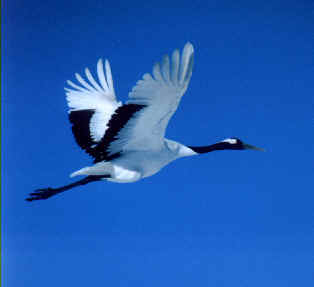
Flying Japanese Crane,
or "Tancho",
(photographed during FONT Feb '05 Japan Tour)

Japanese,
or Red-crowned , Cranes in Hokkaido, Japan
(photographed during FONT Feb '05 Japan Tour )
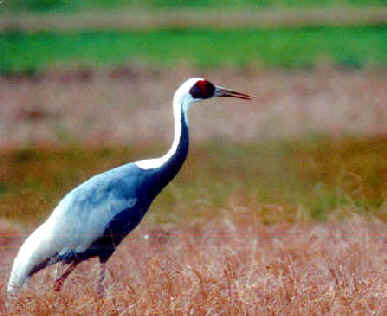
White-naped
Crane in Kyushu, Japan
(photographed during FONT Feb '05 Japan Tour)
Okinawa is one of the southernmost Japanese islands. Most of it is heavily populated, especially the southern and central portions. But the northern part of the island is not. And it was in that area, just over 20 years ago, that a bird became newly-known to science. That bird, with its striking pattern of black, white, and brown, and a bright red bill and red legs, spends most of its time on the ground, and in dense undercover. That bird, not known to science prior to 1981, is the Okinawa Rail.
That northern region of northern Okinawa has been known for years (and for years before 1981) as the only place in the world for one of the rarest birds in the world - the Pryer's (or Okinawa) Woodpecker. It was very close to extinction in the 1930's. Today, its population is still low. Estimates during recent years have ranged from 40 to 100 birds.
So, when we've done FONT birding tours in Okinawa, since the early 1990's, the two top targets have been, of course, the rare woodpecker and the rather newly-discovered rail.
The Pryer's Woodpecker we've seen during all of our Okinawa tours, although sometimes fleetingly and other times leisurely.
But the Okinawa Rail has,
at times, proven to be elusive. It is, after all, a very shy bird. And, there's
a reason why it wasn't known to ornithology until recently.
Oh yes, we have seen it over the
years, in various ways. Sometimes, quickly, as it dashed across a path or a
lightly-traveled small road. Overall, hearing it (at dawn, dusk, and after dark)
has been easy. Seeing it has been hard.
A couple years ago, during one of our tours, we met a young lady in that part of Okinawa, who told us that she routinely saw the bird (that she called by its local name, "Agachi Kumira") as she walked to work in the morning. As unbelievable as that seemed, we went the following morning, to the area along the road that she suggested, and, wow, we saw maybe 10 of them, as we stayed quietly in our vehicle. The birds were walking along the side of the road, by the edge of the tall grass.
During our Feb '05 Okinawa tour, we were ready to see the Okinawa Rail again. This time, we learned from a man, of a place, an opening in a small field of otherwise tall grass, surrounded by brush, where he said the rail could appear. The first time when we went there to the edge of the field, and sat in our vehicle, it did not. We gave it a while, but no rail.
However, later in the day, we
went back, and repeated our approach of sitting quietly, looking, and waiting.
None of those things did we have to do for long. Within moments, at the edge of
the grass, there it was, the Okinawa Rail! This normally-shy bird then
walked out onto the low grass, to give a totally unobstructed view! It was in no
hurry, as it either just stood, or walked slowly about. It even, at one point,
walked directly toward our vehicle, to become too close (yes, too close!) for
those on the opposite side to see it. Then, it drifted back, still not in a
hurry. We were having a look of a life-time at a bird normally so hard to see.
During all this, of course, photos were being taken. One of our tour
participants, with his digital camera, got as many as 140 shots of the bird!
Incredible. Here, now, is one of those many (140) photographs of this attractive
and usually very shy bird, with an ornithological history of only just over 20
years.
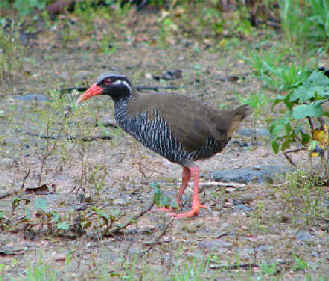
Our group of tour participants
in Japan was kind of interesting as to where they came from. The person who took
the 140 photos of the rail was from England (of course!). Others on the tour
were from Austria and the Netherlands. Another person scheduled to be with us
would have been from Guernsey, but he couldn't come due to a family illness. And
the two people who were with us from Texas were not with "tall hats"
and a drawl. No, they had previously resided in Canada, and prior to that, they
were from Northern Ireland.
And so it was that when, at the appropriate time during the tour, I mentioned
that there was a "Super Bowl" going on in the States, with the
Philadelphia Eagles, no one was interested. It wasn't Philadelphia (or New
England) that no one cared about, Rather, it was just that it was an American
game!
Most of the people that we encountered throughout our tour were Japanese, endemic to Japan. As were some of the birds, entitled "Japanese" that is. During the first part of the tour, for example, in the hills of Honshu, we saw Japanese Accentor, Japanese Grosbeak, and Japanese Green Woodpecker. All nice to see, Two of them, endemic to Japan. The grosbeak also occurs in eastern mainland Asia.
The Pryer's Woodpecker and Okinawa Rail were not the only two rare birds that we saw in Japan. Others included the very rare Black-faced Spoonbill, the Steller's Sea-Eagle, the big and rare Blakiston's Fish-Owl, the Amami Woodcock, and cranes. Among the 6 species of cranes that we saw, those classified as rarities were the Red-crowned (or Japanese) Crane, and the White-naped, and the Hooded Cranes.
Actually, regarding cranes, there was something unusual during our February '05 tour. Normally, we've seen the Red-crowned Crane only on the northern Japanese island of Hokkaido (where there is a resident population). But, this time, we saw one (from the Manchurian population) on the southern island of Kyushu, where it was wintering with the White-naped and Hooded Cranes. It was the first such occurrence there in 37 years! (Incidentally, we've been doing tours to Japan to see the cranes for 14 years.)
A comment needs to be made regarding one of the rarities just mentioned, the Blakiston's Fish-Owl, one of the rarest, and one of the largest owls in the world. In February '05, we saw two. And that kept the streak going. We've seen Blakiston's Fish-Owls during all 16 of our winter birding tours in Hokkaido.
There is now a new, and
informative, feature elsewhere in our website entitled "Rare
Birds of Japan", relating to birds that have been mentioned
here, and others.
Whether you've seen the birds or not (or whether or not you ever will), it's
interesting reading. And particularly so, in the "further notes"
section, are the narratives regarding the Short-tailed Albatross (a bird
that came back from very brink of extinction), the Siberian Crane (one of
the most threatened of all birds), and the Blakiston's Fish-Owl (one of
the most mysterious of birds, as it lives secretly in a remote area).
Also new in our website, there's another feature that's really worth a look.
It's a "Photographic
Sampling of Japanese Culture & Scenery", a series of
photos taken by one of the Canadian participants on our December 2004 Japan
tour. The photographs are not only beautiful, but quite interesting.
That December '04 birding tour was another very good one for birds. Some of the highlights were on the southern island of Kyushu, where between 2 and 3 thousand exquisite Mandarin Ducks were seen, and where we had a good look at the Copper Pheasant (a Japanese endemic that can be hard to see!)
During the most-recent February '05, we went where that pheasant was. No, we didn't see it, but we did see, overhead, 3 Mountain (or Hodgson's) Hawk-Eagles. Two were soaring together in the blue sky, and then perched in trees, where they could be viewed in scopes. Another (the third) was seen later.
During the December '04 Japan tour, in addition to those birds just noted here, all of the rarities mentioned above were seen. That is, except for the Pryer's Woodpecker and Okinawa Rail, as that tour did not go to Okinawa.
Here's the list of our "top birds" during the January-February 2005 FONT birding tour in Japan, as voted by the participants:
1 - OKINAWA RAIL
2 - Steller's Sea-Eagle
3 - Pallas' Rosefinch
4 - Ryukyu Robin
5 - Grey Bunting
6 - Japanese Accentor
7 - White-naped Crane
8 - Blakiston's Fish-Owl
9 - Lidth's Jay
10 - Japanese Grosbeak
11 - Asian Rosy Finch
12 - Mountain (or Hodgson's) Hawk-Eagle
13 - Green Pheasant
14 - Grey-headed Lapwing
15 - Crested Kingfisher
![]()
JAPAN LATE FALL/EARLY WINTER BIRDING TOUR
(Honshu, Hokkaido, Kyushu, & Amami)
December 2004
This tour (our 23rd birding tour in
Japan) was a good one, with lots of nice birds, and some wonderful culture
and scenery, in a land very different for most of us. We went to the Japanese
islands of Honshu, Hokkaido, Kyushu, and Amami.
Between Honshu & Hokkaido, on the
western side of the northern Pacific Ocean,
on November 30th, overnight pelagic trip, onboard a large ferry.
During our Japanese tours, over a dozen years, we've done about 15 such ferry-pelagics,
mostly in January, but also in May, June, November, and December.
This time, there were no albatrosses (Laysan
is nearly always seen, and both Black-footed and Short-tailed have also been),
but there were a number of SEABIRDS.
The most common, this time, was the Black-legged Kittiwake. They occurred
all-day. In all, there were thousands . Other Gulls included Slaty-backed,
Glaucous-winged, Black-tailed , and Vega.
Pomarine Jaegers were with us throughout the day.
In one area, there was a nice number of Shearwaters, mostly Streaked,
but also Short-tailed.. Other oceanic birds were: Northern Fulmar,
Fork-tailed Storm-Petrel, Red-necked Phalarope, Pacifc Loon, and
both Pelagic and Temminck's Cormorants.
Alcids were the Rhinoceros Auklet and Ancient Murrelet.
During another pelagic trip, along that ferry-route earlier this year, in
Such birding at sea is always with the unexpected. It's fun, and particularly pleasant, whether the ocean be either calm or rough, on such a large ferry in the western Pacific.
There is now a new, and
informative, feature elsewhere in our website entitled "Rare
Birds of Japan", relating to birds that have been mentioned
here, and others.
Whether you've seen the birds or not (or whether or not you ever will), it's
interesting reading. And particularly so, in the "further notes"
section, are the narratives regarding the Short-tailed Albatross (a
bird that came back from very brink of extinction), the Siberian Crane
(one of the most threatened of all birds), and the Blakiston's
Fish-Owl (one of the most mysterious of birds, as it lives secretly in a
remote area).
Also new in our website, there's another feature that's really worth a look.
It's a "Photographic
Sampling of Japanese Culture & Scenery", a series of
photos taken by one of the Canadian participants on our December 2004 Japan
tour. The photographs are not only beautiful, but quite interesting.
The December '04 tour was, as noted above, a very good one for birds. Some of the highlights were on the southern island of Kyushu, where between 2 and 3 thousand exquisite Mandarin Ducks were seen, and where we had a good look at the Copper Pheasant (a Japanese endemic that can be hard to see!)
During the December '04 Japan tour, many of the rarities that we had hoped to see were. Among those, with information in the file mentioned above, the "Rare Birds of Japan" were: Amami Thrush, Black-faced Spoonbill, Blakiston's Fish-Owl, Steller's Sea-Eagle, Red-crowned Crane, White-naped Crane, Hooded Crane, Amami Woodcock, Lidth's Jay, White-tailed Eagle, Copper Pheasant, and Ryukyu Robin.
![]()
CENTRAL JAPAN SPRING BIRDING AND NATURE TOUR
(Honshu, including Hegura Island)
May 2004
The following account written by Armas Hill, leader of the tour.
This was our 22nd FONT birding tour in Japan. 14 have been in the winter, and the tour just done was our 8th in the spring.
And it was our 3rd tour with a visit to a most intriguing place, the tiny Hegura Island in the Sea of Japan - one of the best places anywhere to experience and enjoy a spring migration of birds.
That island, Hegura, certainly is small.
It's less than 1 kilometer wide and less than 2 kilometers long. One can walk
the path around the entire coastline of the island in less than an hour.
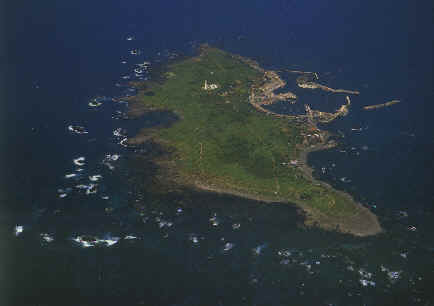
Some people live on that small island. But not many, about 50. In the morning, the women of Hegura dive for seaweed. Later in the day, if sunny, they put it out to dry. Men go out on boats to fish.
There was a small store on the island. But no longer. When I asked a young Japanese girl who spoke some English, how, for example, she would buy food or other items, she told me she would order such things on the internet, and they would be brought on the ferry, from the small city of Wajima, about two hours away by boat.
There is a school on the island, with an enrollment of 5 students.
Fortunately, something that does exist on the island is a small inn, where visitors, such as us, can sleep Japanese-style on the floor, and where meals, Japanese-style, can be eaten. Assorted seafood, along with locally-grown seaweed, locally-grown vegetables, and noodles and rice are served. But the place is great for 2 or 3 days not just to experience some rural Japanese living, but to have, virtually outside the door, some truly tremendous birding during spring migration.
A bit more can be said about the island, off the west coast of Japan, and east of Korea and south of Manchuria. Birds that pass through Hegura, arriving either at night or by day, include not only those that travel north through Japan, but also some species more common in those other lands of Korea and Manchuria.
The tallest structure on the island is a white lighthouse, located near a small woodlot, where the traveling birds stop to rest. The pines and other short trees and bushes, are for a while the haunts of migrating birds. Others occur in such places as a field of tall grass, a small garden, the playground of the school, or in the debris that may be strewn by the buildings. Birds can be anywhere. Along the path that encircles the island, there are about six shrines by the sea, near the mostly rocky coastline. Birds of various kinds are to be found in that setting, in the rocks or by the pools.
The ferry goes once a day, each direction, between Wajima and Hergura Island, in the morning to the island, late in the afternoon from it. During the ferry-rides, there can be nice seabirding. In the spring, the endemic alcid, known in English as the Japanese Murrelet, and in Japanese as the "Kanmuri-umisuzume", can be seen. "Umisuzume" is a Japanese word meaning "sea sparrow". Another alcid in those waters is the Rhinoceros Auklet. Streaked Shearwaters can be seen in large numbers from the ferry, as can Red-necked Phalaropes. On our way to Hegura this time, there was a Red Phalarope or two among the flocks of Red-necked. On our way from Hegura, we went through an area with swarms of Streaked Shearwaters. There were hundreds of them flying about near the boat.
On the island itself, during our 3-day visit that was part of the Spring '04 FONT Japanese birding tour, about a hundred species were found. In that total, there were landbirds (many), shorebirds and waterbirds. Probably more species, and more individual birds, can be found on Hegura during a good day or two in May than maybe anywhere else in Japan. And with the strong probability of rarities, there's the potential for more birding excitement in the spring on Hegura than at any other Japanese locale.
For that reason, not just the birds but Japanese birders migrate to Hegura in the spring en mass. Again of us, this time on Hegura as during our previous times, we mingled with a number of Japanese birders, even with our differences in language and culture notwithstanding. Our experience in a place so far away from our homes, and so different than where we live, will always be remembered.
Another experience that's fascinating, no matter where it is in the world, is to be in the midst of a major bird migration. It can be done at various particular spots in the world, some of which are well-known such as Point Pelee in Canada in the spring, Cape May in the eastern US and Falsterbo in southern Sweden, both in the fall. But the phenomenon on Hegura Island off Japan in the spring, with the right conditions, is about as good as it gets.
The "bird island" of Hegura can be for a birder a bit like a "fantasy island". It's a place where one can become immersed in birds. It's also a place so very far removed from our everyday lives, without hustle or bustle. Just to relate in perspective how special a place Hegura can be to a Japanese birder, we met some who found it worthwhile to travel for more than a day in each direction, between their homes and Hegura, in order to spend even just a few hours on the island between the ferry-arrival in the morning and the ferry-departure in the afternoon.
Also interesting to think about is how much time the migrating birds spend on the island. Some birds seem to stay more than a day. Others seem to be island-bound just a short time. Some Hobbies and Peregrines that appeared to arrive during an afternoon, to perch in pine trees and on a communications tower, were gone the next morning. During one day, Cuckoos heard calling were mostly Oriental. The following day, the sound of the Common Cuckoos was more predominant.
One thing that's especially good about birding on Hegura is that birds that can elsewhere be notorious skulkers are often more readily seen. In that category, on Hegura in the spring, are birds such as the shy Japanese Robin (mostly in late-April), the Siberian Blue Robin (mostly in early to mid-May), and the White's Ground Thrush (in April & May).
Routine spring-time migrants on Hegura, come from the southeast Asian tropics and continue onward to their northern breeding grounds. Hence, the adjective "Siberian" occurs more than once. Such birds include the Siberian Rubythroat, Siberian Stonechat, and the Siberian Thrush (in addition to the Siberian Blue Robin, already mentioned). Others include the Yellow-breasted Bunting and the Blue-and-white Flycatcher, with males of both bright and colorful.
Already mentioned, in regard to Hegura, has been aspect of birds occurring that are more commonly seen on the Asian mainland than they are otherwise in Japan. Birds in that category during our '04 tour included the Swinhoe's Robin, Mugimaki Flycatcher, Tricolored Flycatcher, Black-naped Oriole, Tristram's Bunting, and Chestnut Bunting. Trevor, in our group, who had migrated from Australia to join us, was lucky to see all of these. Lucky, yes, but the birds were due as much to his persistence, as he walked almost as much as one could in Australia (in order to be "at the right place at the right time").
During one of our days on Hegura in May '04, Mugimaki Flycatchers were actually common. That Japanese name notwithstanding, the species is normally a rarity in Japan.
In one area on the island, in brush by a garden, there were over a half-dozen Chestnut Buntings, with an assortment of buntings of other kinds. None of them were more attractive than the male Chestnut (its coloration chestnut and yellow). To go where the Chestnut Bunting would be seen in its attractive attire on its breeding grounds, one would go to the region of Manchuria and eastern Siberia.
Some mostly bright-yellow Black-naped Orioles were seen during our tour. They also breed in Manchuria, as well as in Korea and China.
To see such birds as the bunting and the oriole and other of Asia on the island less than a kilometer wide certainly involves a lot less travel would be required elsewhere.
Some Old World Flycatchers were
particularly abundant for us on Hegura in mid-May '04. In addition to the Blue-and-white
(the male when low in a bush is a beauty), and the rare Tricolored and
the Mugimaki, there were others in the flycatcher tribe the Asian
Brown, the Sooty (or Dark-sided), the Gray-streaked,
and the Narcissus, the last of these a particularly attractive Japanese
bird. They don't come much more attractive.
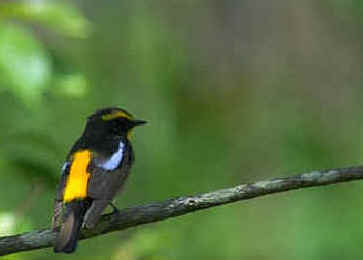
Old World Warblers are quite different than those of the New World. While the latter are considerably more colorful, the former can be more challenging to ID. But that's not as hard to do when one flies into a window of the inn where we stayed, and then stunned, it can be held in the hand - as it was in the hand of Ellen from Massachusetts. That Arctic Warbler (the borealis subspecies, with the yellowish vent) did recover. A short while after its colliding with the window, it was well to fly away - it would have a long way yet to go to the northern hinterlands of Siberia. Other migrating warblers included the Hume's (formerly Yellow-browed), the Sikhalin (formerly Pale-legged) and the Eastern Crowned. The latter was the most common, but any of them could be found in any tree or bush.
One of the 3 species of Old World Cuckoos that we saw, the Lesser, was seen sitting on a rock by the sea, as it rested before it would continue on its way.
3 species of Shrikes were seen during our '04 tour on Hegura. The Bull-headed is common throughout much of Japan, but there were also fine looks at the Tiger (or Thick-billed) Shrike, and the Brown. The latter is a much more attractive bird than its name implies.
Among the Thrushes we saw on Hegura, again the name Brown is not quite enough for that bird with a reddish breast that rather resembles an American Robin. Other thrushes during the tour included the Dusky, the Eye-browed, the Pale (another weak name), and the Japanese Grey, in addition to the Siberian and White's Ground Thrush already mentioned. All of these were migrants on the island. The Blue Rock Thrush (with a chestnut belly) is a resident.
A small group of Ashy Minivets arrived on the island, appearing in low trees by the inn, just as we were about to go for the ferry to leave the island. How good it was for such nice birds to come right to us as we had just about run out of time (and as our weary feet were about to make their one last island-walk to the dock).
One last, interesting thing about the birds of Hegura. A number of the birds most common on the main Japanese islands, such as Honshu, are absent, or nearly so, on Hegura. There are no Tree Sparrows or Grey Starlings. Bulbuls and White-eyes are few and far between. There are some crows, but not many. Woodpeckers and tits do not occur. Nor do birds such as the Japanese Wagtail (which is common only a couple hours away) or the Japanese Green Pheasant. All the birds noted in this paragraph are among the most common throughout much of Japan. For example, in virtually every Japanese city, Eurasian Tree Sparrows are abundant. (It's an interesting side-note that there are no House Sparrows anywhere in Japan. Yes, birds are different there on the other side of the world.)
Cumulatively, 127 species of birds have been seen during the 3 FONT tours on Hegura Island. About a hundred species were seen in '04. A cumulative list of the birds on Hegura during our tours can be readily found from the home-page of our web-site www.focusonnature.com
A list of the Hegura birds during our May '04 follows here:
1 - Streaked Shearwater (offshore)
2 - Temminck's (or Japanese) Cormorant
3 - Pelagic Cormorant
4 - Black-crowned Night-Heron
5 - Cattle Egret
6 - Little Egret
7 - Intermediate Egret
8 - Great Egret
9 - Grey Heron
10 - Pacific Reef-Heron (both light & dark morphs)
11 - Eurasian Wigeon
12 - Spot-billed Duck
13 - Red-breasted Merganser (1 bird, out of season)
14 - Black (-eared) Kite
15 - Osprey
16 - Northern Marsh-Harrier (the far-eastern subspecies)
17 - Hen Harrier (no longer considered conspecific with the Northern Harrier of
North America)
18 - Japanese (or Lesser) Sparrowhawk
19 - Eurasian Hobby
20 - Peregrine Falcon
21 - Moorhen (or Common Gallinule)
22 - Mongolian Plover (or Lesser Sandplover)
23 - Pacific Golden Plover
24 - Red (or Rufous) -necked Stint
25 - (Ruddy) Turnstone
26 - Common Snipe (no longer considered conspecific with what's now the Wilson's
Snipe of North America)
27 - probable Latham's (or Japanese) Snipe
28 - Common Greenshank
29 - Common Sandpiper
30 - Grey-tailed (or Polynesian) Tattler
31 - Red-necked Phalarope (seen from the ferry)
32 - Red (or Grey) Phalarope (seen from the ferry)
33 - Black-tailed Gull
34 - Vega (form of the Herring) Gull
35 - Slaty-backed Gull
36 - Japanese Murrelet (seen from the ferry)
37 - Feral Pigeon
38 - Rufous (or Oriental) Turtle-Dove
39 - Japanese (or Black) Wood-Pigeon
40 - Common Cuckoo
41 - Oriental (or Himalayan) Cuckoo
42 - Lesser Cuckoo
43 - Japanese (formerly part of Collared) Scops-Owl
44 - a swift with 3 English names, either Pacific, or White-rumped, or
Fork-tailed Swift
45 - Eurasian Kingfisher
46 - (Barn) Swallow
47 - Bank Swallow (or Sand Martin)
48 - Red-rumped Swallow
49 - Olive-backed Pipit (has also been called Indian Tree Pipit)
50 - Yellow Wagtail (the subspecies simillima)
51 - Grey Wagtail
52 - Black-backed Wagtail
53 - Brown-eared Bulbul
54 - Ashy Minivet
55 - Swinhoe's (or Rufous-tailed) Robin
56 - Siberian Blue Robin
57 - Siberian Rubythroat
58 - Daurian Redstart
59 - Siberian Stonechat
60 - Blue Rock Thrush (red-bellied form)
61 - White's (or Scaly) Ground Thrush
62 - Siberian (Ground) Thrush
63 - Brown (or Red-bellied) Thrush
64 - Pale Thrush
65 - Eye-browed (or Grey-headed) Thrush
66 - Dusky Thrush
67 - (Japanese) Grey Thrush
68 - Japanese Bush Warbler
69 - Eastern (or Oriental) Great Reed Warbler
70 - Black-browed (or Schenk's) Reed Warbler
71 - Eastern Crowned (Willow-, or Leaf-) Warbler
72 - Sikhalin (or Pale-legged) (Willow-, or Leaf-) Warbler
73 - Hume's (has been part of Yellow-browed) Warbler
74 - Arctic Warbler (subspecies borealis)
75 - Blue-and-white Flycatcher
76 - Asian Brown Flycatcher
77 - Sooty (or Dark-sided) Flycatcher
78 - Grey-spotted (or -streaked) Flycatcher
79 - Mugimaki Flycatcher
80 - Narcissus Flycatcher
81 - Tricolored (or Yellow-rumped) Flycatcher
82 - Japanese White-eye
83 - Bull-headed Shrike
84 - Brown Shrike
85 - Tiger (or Thick-billed) Shrike
86 - Carrion Crow
87 - Large-billed Crow
88 - Red (or Violet) -cheeked Myna
89 - Black-naped Oriole
90 - Oriental (or Grey-capped) Greenfinch
91 - Eurasian Siskin
92 - Eurasian Bullfinch
93 - Japanese Grosbeak
94 - Hawfinch
95 - (Japanese) Grey Bunting
96 - Black-faced Bunting
97 - (Japanese) Yellow Bunting
98 - Yellow-breasted Bunting
99 - Chestnut Bunting
100 - Rustic Bunting
101 - Tristram's Bunting
There were also birds, of course, seen elsewhere during our May '04 Japan Spring Birding Tour, other than on Hegura.
Among the best were these:
Along the west coast of Japan, in some trees that were budding, birds, mostly Bulbuls were feeding. But among them were some absolutely beautiful Waxwings, Bohemian Waxwings, that occur in Japan as wanderers mostly in the winter. Japanese Waxwings also winter in Japan, but our birds were with red and white on the wings and yellow on the tails.
On a small pond in central Honshu, there was another species still present that's more apt to be a Japanese winter visitor. There was a pair of Smews, a red-headed female, and a brilliantly patterned black-and-white male.
Shorebirds (called waders in the Old World) were enjoyed in eastern Honshu, with many, during their northward migration, in fine breeding plumage. Particularly nice, in an area of mudflats, were Bar-tailed Godwits, Mongolian Plovers, and Great Knot.

In flooded rice-fields, there were many to see including Sharp-tailed Sandpiper, Curlew Sandpiper, Red-necked Stint, Dunlin, Terek Sandpiper, Whimbrel, Pacific Golden Plover, Snipe, Ruddy Turnstone, and Grey-tailed Tattler. Such traveling shorebirds are nice to see anywhere in the world that they happen to be, especially when in their nuptial attire.
In a reedy marshland, we saw two specialties the Japanese Reed Bunting as it sang its song, and the Japanese Marsh Warbler as it did its aerial display. In the Birdlife International publication, "Threatened Birds of the World", both of these rare & localized Japanese breeders have alternate names the Ochre-rumped Bunting and the Marsh Grassbird. To Japanese birders, they're known, respectively, as ""Ko-jurin" and "O-sekka".
Nearby, another avian denizen of the Japanese marshes was making its loud racket, the Oriental Great Reed Warbler, called the "O-yoshikiri" in Japanese. Its noisy calls were incessant, in whatever language.
Hopefully, this narrative has given to all who have read it, a good image of what was a very fine May '04 Spring Birding & Nature Tour in Japan.
![]()
JAPAN WINTER BIRDING TOUR
(Honshu & Hokkaido)
January 2004
The following account written by Armas Hill, leader of the tour.
In January 2004, we conducted out 21st birding tour in Japan. Once again, it was our annual winter birding tour
that we've been done since 1992. Each year, during the tour, there's been a pelagic trip onboard an overnight ferry on the Pacific from Honshu north to Hokkaido.Our day on the ferry this year, January 14th, was a more-than-blustery one, with gale-force winds at sea. The waves reached more than 20-feet. However, the ferry on which we rode was a very big vessel, and stable even with the conditions. Most places, to have a pelagic trip on such a day would not be possible, as the surface of that "not-so-Pacific" ocean was virtually covered with whitecaps. Thus, it was for us an interesting opportunity to observe birds over an ocean in such strong weather.
The ferry, during part of the trip, was only a couple miles offshore from the rugged, hilly northern coast of
Honshu (the main Japanese island). That region of the island is nearly unpopulated (in contrast with other places, to the south, that are filled with people).The next day we were on land, on the very wintry northern Japanese island of
Hokkaido, where our tremendous birding continued in the snowy land with cranes, eagles, and an owl.The next day, during our Japan 2004 tour, we saw about a hundred eagles along the eastern Hokkaido coast. They were about evenly divided between White-tailed and Steller's Sea-Eagles. The latter, absolutely spectacular birds to see.
Another bird that eats fish ended that great January day for us on Hokkaido. It was another bird spectacular to see, the Blakiston's Fish-Owl. We saw 3 of them, very well. We were looking at their orange eyes, within an hour after the orange ball of the sun was about to set. The Blakiston's Fish-Owl is among the largest and the rarest of the world's owls.
The snow in Hokkaido has already
been mentioned. During our '04 tour , scenes of snow in the trees were
exceptionally beautiful, as was, at a large mostly-frozen lake, another winter
spectacle of birds. Flocks of Whooper Swans were there, in the mist that
rose from the water. They called loudly as together they performed a variety of
gyrations.
The next day, after an airplane flight and a bullet-train ride, we were, back on
the main Japanese island of Honshu, at a
very big lake with many waterfowl. Falcated Teal, Spot-billed Ducks,
Tufted Ducks, Pintails, and Pochards were common. Eurasian Wigeon were
abundant. But the nicest flock was that of a tight group of mergansers
fishing above where there was apparently a tight school of fish beneath the
surface. Some of the flock were Goosanders (known in North America as Common
Mergansers). Others in it were Smews (a merganser
that does not normally occur in North America). Many of the Smews
were males, with their striking white-and-black plumage. As many as 50 Smews
were together, diving as they fed on the fish.
Probably the "duck of the day" was one on a small nearby pond, a drake
Baikal Teal. At that small pond, Common Teal were that. There were
hundreds. But there was only one Baikal, which was enough to make us
happy. The Baikal Teal of Asia is rare and threatened species.
A day or so later, on the
southernmost of the main Japanese islands, Kyushu,
we had, in the afternoon, yet another waterfowl spectacle. In a valley in
a particularly rugged area of the island with steep rocky gorges, there were Mandarin
Ducks by the hundreds. The water of the river was close to an emerald green.
The colorful plumages of the male Mandarins were extravagant. The wild
Mandarins were in scattered flocks along the river where it was slow-flowing. Of
all the masses of the waterfowl we saw during our '04 tour, these masses of
Mandarins in Kyushu were by far the most wary. One simply could not get close to
them, as one would, along the road, get out of the car. "City park
ducks" these were not.
When they were on the water (and we could observe them nicely in scopes),
the Mandarins were quite vocal. In this strikingly beautiful, and otherwise
quiet, setting in Japan, it was for us a wonderful experience. At the end of the
day, the Mandarins flew up high in flocks to go roost in trees (as their
counterparts in North America, Wood Ducks do.)
Along that river valley, where the water was more fast-flowing, there were Brown
(or Pallas') Dippers, Grey Wagtails, and Crested
Kingfishers. In bushes, there were Yellow-throated Buntings.
Birds have just been mentioned along one particular river in Kyushu. On every
river on that island, in '04, especially near the sea, there were many ducks
(other than Mandarins). The most numerous were Wigeon (all Eurasian,
no American).
Among gulls along the Kyushu coast during our tour, the best was the rare
Saunder's Gull, a dainty gull that breeds nearly exclusively in China (only
sporadically on the west coast of Korea). When we visit Okinawa in the
winter, we see a few. On Kyushu, over the years, we've seen less.
But it's the cranes that are the primary avian attraction on Kyushu in
the winter. Nearly the entire global population of Hooded Cranes (5,000
or so birds) winter there, as does a high proportion of the world's White-naped
Cranes (about 2,500 birds). Their congregation from late-November
thru mid-February is a true spectacle. Among them, each year, there are some
crane vagrants. In '04, we saw 3 Common, or Eurasian, Cranes, a
rare Siberian White Crane, and 1 Sandhill Crane (the last of
these in Japanese is called "Kanada-zuru", with "zuru" their
word for "crane"). (Actually, although many Sandhills
nest in Canada, some do so in Siberia. Most of them winter in North America
south to Mexico. Those seen in Japan annually, usually 1 or 2, probably come
from Siberia.) Most of the many Hooded Cranes breed in Siberia, as do
the Common Cranes (some Hooded-Common hybrids occur in
Japan in the winter). The White-naped Crane nests mostly in northern
China, with some in Mongolia. The rare Siberian White Crane nests in
far-northern Siberia, with most wintering in China.
Some winters there are as many as 7 species of cranes in Japan. In 2004, there
were 6, and we saw them all: the Hooded, White-naped, Siberian, Common,
and Sandhill in Kyushu, and the Red-crowned (or Japanese) Crane,
as noted earlier, in Hokkaido.
When we first arrived in the area of the cranes in southern Kyushu, an area
where nearby there are citrus groves, there was, during January 21, '04, snow!
At first, during the blinding snow, we could not hardly see the cranes. We could
hear them. We learned through a Japanese translator with us that it was the
first such snowfall in that lowland area in 40 years (or so)! There are no
snow-plows or snow-shovels in that part of Japan. People were
"shoveling" with cardboard. A couple hours and about 4 inches of snow
after our arrival, the sun broke through for a while, and somehow, during about
an hour or so, we saw all 5 of the crane species present. We were most fortunate
to have a close and very good look at the Siberian White Crane, as it fed
in a field with the White-naped and Hooded.
During our last morning of the tour, back on Honshu,
in the area of shrines and temples in Narita (northeast of Tokyo), we
saw, during the final act before the curtain closed at the nearby airport, a
last nice assortment of Japanese birds. In the woods and by ponds and a stream,
there were: a pair of Japanese Wagtails walking on thin ice, a flock of
two of colorful Varied Tits and Japanese White-eyes, a large
flock, higher in the trees, of Long-tailed Tits, a Japanese Grey
Bunting on a stone at a shrine, and Pygmy Woodpecker and Great
Tits along with Hawfinches, Pale Thrushes, and Brown-eared Bulbuls.
To and from the shrine, we walked along narrow streets where shop-keepers and
restaurant owners were beginning their days. It was a more than interesting, a
fascinating, walk surrounded by Japanese culture. There were so many things to
be eaten, but not recognized. Among those memorable, however, were chestnuts
roasting in water in small pots. It was a nice last morning for us in Japan.
During our January 2004 Japanese Winter Birding Tour, we had some wonderful
experiences with birds and otherwise, that we'll always remember.
A total of 356 species of birds have cumulatively been seen during FONT tours in
Japan. The fore-mentioned Gyrfalcon, in '04, was number 356. A complete listing
of birds during FONT Japanese tours is in our web-site.
To
Top of Page
![]()
The following account written by Armas Hill, leader of the tour.
During our annual winter birding tour in Japan, January 13-25, 2003, highlights included:
4 Blakiston's Fish-Owls, 2 of them
adults, a juvenile, and a sub-adult.
The species, inhabiting the northern
Japanese island of Hokkaido and eastern Siberia, is one of the rarest of the
world's owls, and one of the largest.
Also in Hokkaido, one evening, we saw a Ural
Owl, well, as it sat on a roadside branch.
Cranes are always a highlight of our Japan winter birding tours. This year, 6 species of cranes were wintering in Japan, and we saw them all the beautiful Red-crowned Cranes displaying on the snow, and the masses of Hooded and White-naped Cranes, along with a couple Common Cranes, a Sandhill Crane, and a Demoiselle Crane.
Also exciting during our Japan tours in winter are Eagles both Steller's and White-tailed, along the Hokkaido seacoast.
Waterfowl during the tour that are always great to see included exquisite Mandarin Ducks, gaudy Harlequin Ducks, attractive Smews and Falcated Ducks, and a fine male Baikal Teal. Another rarity, the Scaly-sided Merganser, was also seen.
Wonderous white Whooper Swans were along the edge of a frozen Hokkaido lake, giving their loud calls, as a couple black Ravens were calling overhead as they flew by.
From the offshore ferry from Honshu to Hokkaido, some Laysan Albatrosses were seen. Also Shearwaters (Streaked and Short-tailed), Fulmars and Kittiwakes. Alcids included both Common and Thick-billed Murres, Ancient Murrelet, and Least Auklet. The last of these, as well as Spectacled Guillemot, were also seen from shore in Hokkaido.
A couple rarities seen during the Kyushu portion of the tour were the Black-faced Spoonbill and Saunder's Gull.
The dapper Yellow-throated Bunting was
among an assortment of buntings, and other landbirds.
Bramblings, en masse, made an
interesting observation. A tight flock of over a thousand was seen swirling
about in flight, and then alighting by us on the ground.
As our second Japan tour, January 24-31,
began on the
southern islands of Amami and Okinawa, a pair of striking Lidth's Jays
(endemic to Amami) was observed, close at hand, as they were gathering nesting
material. Although that jay can be noisy, as they were about us - they were
absolutely silent.
Also seen well during that tour, as they gathered nesting material, were 2
Pryer's Woodpeckers on Okinawa. That species, sometimes called the Okinawa
Woodpecker, is endemic to one region of that island, and is probably the rarest
of the world's woodpeckers (assuming that the Ivory-billed is extinct).
According to Birdlife International, in the early 1990's, the breeding
population was estimated to be less than 80 birds, and the total population
possibly as low as 150 birds. The entire range is less than 600 square
kilometers.
Other rarities in the Nansei Shoto region in southern Japan include the Okinawa
Rail (endemic to Okinawa) and the Amami Woodcock (mostly on the island of
Amami). Both were seen briefly. The rail was heard at dusk. During our Okinawa
tour, prior to this, in May, Okinawa Rails were more readily seen, early in the
morning - about a dozen. The species can be notoriously difficult to see. It was
not known to science until 1981.
Seen very well in Okinawa were 2 other rarities: the Black-faced Spoonbill and
Saunder's Gull, both at a mudflat. There was one spoonbill (of a total
world population of less than 700), and about a half-dozen Saunder's
Gulls. Okinawa is a wintering site for the latter species, which breeds in
eastern China at just a few places (7 colonies in 4 provinces).
Also on the Okinawan mudflat, among other shorebirds, there was a species
"new" for our cumulative bird-list from 20 FONT Japanese tours, number
#355: Two Pied, or Eurasian, Avocets were walking and feeding on
the mud. Beautiful, striking birds!
These were some of the highlights during
our Japan winter tours in 2003.
We'll be going, again, next winter, in
January 2004.
Before that, Japan tours are scheduled, as well, for the Spring of '03, including visits to places for the Pryer's Woodpecker and Okinawa Rail.
![]()
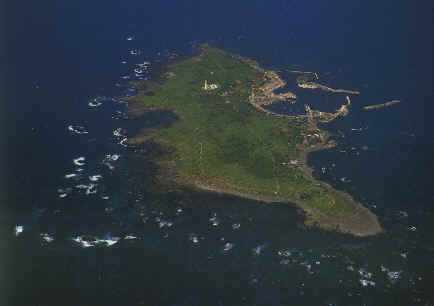
During the FONT 2002 Early-Spring Birding Tour in Japan, we went again to Hegura Island (this time in early May). We visited the island previously during our tour in 2001 (in late April).
Again in 2002, as in 2001, we had some extraordinary birding. This year, among the best of the birds were the Swinhoe's Robin, Mugimaki Flycatcher, Tristram's Bunting, and Dusky Warbler. The most obvious bird on the island, during our stay in 2002, was the attractive Narcissus Flycatcher. Colorful, and tame, they always seemed to be with us.
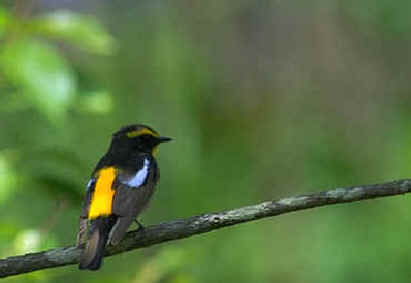
Narcissus Flycatcher
Also there were Siberian Blue Robin, White's Ground-Thrush, Eye-browed Thrush, Violet-backed Starling, and Yellow-throated Bunting. During the time of our visit, there were always birds about, and Japanese birders with whom we shared our wonderful experience on the island and an exciting phenomenon of bird migration.
Returning from Hegura Island to Honshu, we had with us, during our entire 2-hour ferry ride, Streaked Shearwaters, thousands of them.
Before going to Hegura-jima, on Honshu we observed a noteworthy assortment of migrating shorebirds (or waders), including both Great and Red Knots, thousands of Pacific Golden-Plovers, colorful Mongolian Plovers in breeding plumage, Red-necked Stints in bright breeding plumage as well, and a Broad-billed Sandpiper among Dunlin and Grey-tailed Tattlers, to mention a few of the shorebird species.
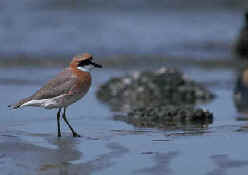
Mongolian Plover
Among landbirds on Honshu during the tour were both the Japanese Reed Bunting and Japanese Yellow Bunting (both rare species), breeding Mandarin Ducks, and also colorful Japanese Green Pheasants, and Japanese Grosbeaks. Also among the five assortment of birds found, there was a single (late) male Smew, and a line-up on a branch of 10 young Long-tailed Tits, huddled together, as they were being fed by adults.
The "Top
Birds" as voted by participants after the tour were:
1 - Narcissus Flycatcher
2 - Mugimaki Flycatcher
3 - Tristram's Bunting
4 - Siberian Blue Robin
5 - Long-tailed Tit (a line-up of 10 young on a branch)
6 - Japanese Marsh Warbler
7 - White's Ground-Thrush
8 - Swinhoe's Robin
9 - Brown Dipper
10 - Mongolian Plover
11- Varied Tit
12 - Japanese Green Pheasant
13 - Japanese Green Woodpecker
14 - Broad-billed Sandpiper
15 - Yellow-throated Bunting
16 - Great Knot
17 - Japanese Bush Warbler (singing)
18 - Mandarin Duck
19 - Streaked Shearwater
20 - Japanese Grosbeak
A booklet listing the 353 species of birds that have been found during FONT tours in Japan, noting when and where, is available from FONT. Let us know if you'd like a copy.
![]()
Over the years, FONT has conducted a number of birding tours on the Southern Japanese Island of Okinawa, where among the interesting birds there are 2 endemics to the island the Pryer's Woodpecker and the Okinawa Rail.
The woodpecker is very rare. Assuming the Ivory-billed Woodpecker to be extinct, the Pryer's would be the rarest of the world's woodpeckers, only occurring in a limited area of forest in northern Okinawa. Population estimates have ranged from 40 to 200 birds. During our current tour on the island, as we walked along a trail in a woods by a stream, we found ourselves face-to-face with a Pryer's Woodpecker, bringing food to young in a nest. This was the first of 8 Pryer's Woodpeckers to be seen during the tour. And we heard the young woodpeckers inside the nest cavity.
The Okinawa Rail was only "discovered" in 1981, new to science at that time, although known for years by locals to be in the Yambaru Region of Okinawa. The bird can be very hard to see. Secretive, shy, in the forest or high grass. Thus, it was "unknown" as long as it was. During our tour now in Okinawa, during the early morning of May 16, 2002, we saw a total of 11 Okinawa Rails (and heard another). The birds were seen along a stretch of road, as we moved slowly in our vehicle. At one time, as we remained still on the road, there were 3 rails ahead of us. One, more closely, was feeding on low vegetation along the side of the road. Two were behind it. One of them raised its neck and began to call. On another occasion, as we sat still, an Okinawa Rail was walking along the road edge, just about 15-feet from us. The species is quite attractive, with a bright red bill and legs, a black-and-white barred belly, a mostly black head with a white stripe and red eyes.
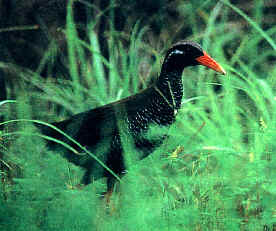
Okinawa Rail
Also attractive during our May 2002 tour in Okinawa have been at least 4 Greater Painted-Snipes seen well in a rice paddy (females more colorful as in phalaropes), a Ruddy Crake with 2 black chicks, Ryukyu Robins (at least 20 seen well), and Japanese Paradise Flycatchers. At an estuary, we observed 2 Terek Sandpipers with a flock of Grey-tailed Tattlers.
The "Top
Birds" as voted by participants after the tour were:
1 - Okinawa Rail
2 - Pryer's Woodpecker
3 - Oriental Pratincole
4 - Ruddy Kingfisher
5 - Greater Painted-Snipe
6 - "Owston's" White-backed Woodpecker
7 - Terek Sandpiper
8 - Japanese Paradise-Flycatcher
9 - Narcissus Flycatcher
10 - Ryukyu (formerly part of Narcissus) Flycatcher
11- Grey-faced Buzzard
12 - Japanese Reed Bunting
13 - Ryukyu Robin
14 - Mongolian Plover
15 - Ryukyu Scops-Owl
16 - Japanese Green Pheasant
17 - Sharp-tailed Sandpiper
18 - Little Stint (rare in Japan, seen well)
19 - Azure-winged Magpie
20 - Great Knot
21 - Needle-tailed Swift
22 - Oriental Scops-Owl
23 - Japanese Wagtail
A booklet listing the 353 species of birds that have been found during FONT tours in Japan, noting when and where, is available from FONT. Let us know if you'd like a copy.
![]()
JAPAN
- WINTER BIRDING THE LENGTH OF THE COUNTRY
January
2002
Tour JA-1: Hokkaido, Honshu, Kyushu: Jan 15-26
Tour JA-2: Amami, Okinawa: Jan 26-31
with:
Blakiston's Fish-Owl
cranes, eagles, and much more
Written by the leader, Armas Hill, following
the 16th FONT Japanese birding tour.
Bird highlights during the tours
were many, ranging from 2 Blakiston's Fish-Owls, close at hand, to 5
rare Pryer's Woodpeckers.
There were 7 of the world's 15 species of
cranes.
There were both of the Eagles of Hokkaido, the White-tailed
and the Steller's.
Baikal Teal was sought and found.
The most Mandarin
Ducks for us, ever, were seen.
Whooper Swans were enjoyed, calling on
water of a cold lake enshrouded in mist.
Not just Blakiston's, but other owls
provided experiences not to be forgotten. And yet another bird of the night
provided quite a show, the rare Amami Woodcock.
As we birded the country of islands, from one end to the other, from cold Hokkaido to warmer Okinawa, each day, being different from the others, had highlights unto itself. Day by day, descriptions follow.
We began in Tokyo on January
15. In the "green island" of trees in the city, at the Meiji
Shrine, we saw our first Varied Tit, Japanese Bush-Warbler, Red-flanked
Bluetail, Dusky Thrush, Japanese Pygmy-Woodpecker, Hawfinch, and a
flock of about 50 Mandarin Ducks. A good way to start. A Sparrowhawk
flew quickly overhead. Large-billed Crows made their assortment of calls.
Earlier in the day, we saw our only Azure-winged Magpies of the tour. The
subway rides to and from the shrine were fun, and enjoyable to see at the shrine
was a wedding. Our first day in Japan was actually a national holiday
("Coming-of-Age Day"), and we saw a number of Japanese ladies in
attractive kimonos.
In the afternoon, at another Tokyo park, we saw our first Kamchatka Gull,
Smew, and numerous other ducks. At night, north of Tokyo, we
boarded a ferry headed for Hokkaido, on which we soundly slept.
During January 16, our pelagic day on the Pacific Ocean, off Honshu, nearly 40 Laysan Albatrosses were tallied. An immature Short-tailed Albatross was seen, but not by all. There were numerous Common and Thick-billed Murres. As the ferry plowed north, all of these murres (or guillemots as they are otherwise known), were apparently unable to fly, as they scurried away from us on the water. Other alcids included: Ancient Murrelet, Crested Auklet, and Tufted Puffin. Kittiwakes were plentiful. Northern Fur Seals were seen floating on the surface of the ocean.
Onshore this evening, nestled away in the woods of Hokkaido, we enjoyed our first, and one of our best, traditional Japanese dinners.
The morning of January 17 began with snow gently falling. Tree branches and the ground were covered with a few fresh inches making a beautiful sight and a nice backdrop for some birds that would be attractive anyway, Common Bullfinches with their subtle rosy-and-gray coloration. Five species of tits, a nuthatch, and a jay, were enjoying their breakfasts at bird feeders outside the windows of a room where we were enjoying ours. In nearby trees, there were White-backed and Grey-headed Woodpeckers. In the afternoon, we travelled east across Hokkaido. Animals along the way included Sika Deer, Red Fox, and Arctic Hare.
On January 18, we spent a good part of a very good day with as many as 180 Red-crowned, or Japanese, Cranes, as they were calling, leaping, and sometimes just standing gracefully on the snow. That afternoon, a man dispersed some small fish on that snow, and the cranes were joined by a number of White-tailed Eagles and Black-eared Kites. The raptors flew in close to us, as they lowered their talons to the ground grabbing the fish.
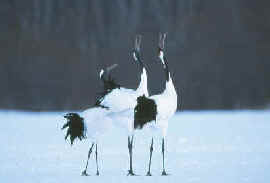
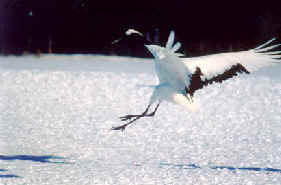
Red-crowned (Japanese) Cranes,
during a FONT Japan Winter Birding Tour,
photo © by
Allan Beach, of Ohio, USA.
Our day ended with a close look at 2 huge Blakiston's Fish-Owls, shortly after sunset. They both perched in a bare tree not far from us. As a light shone on them, we saw them so very well. Happy we were, sleeping that night so very well.
On January 19, we saw as
many as 120 Harlequin drakes and ducks along the shoreline of the
Shiretoko Peninsula in eastern Hokkaido. Also that day, along that wintry coast,
our tally of magnificent Steller's Sea-Eagles was 170, both
immatures and adults. Birding doesn't get much better, anywhere, than it was for
us this and the previous day.
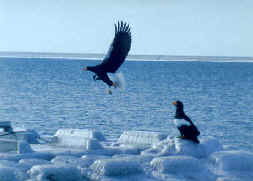
Steller's Sea-Eagles,
during a FONT Japan Winter Birding Tour,
photo © by
Allan Beach, of Ohio, USA.
The 19th of January began with
some flocks of Whooper Swans along the edge of a large lake. The large
white birds would be obvious enough, but they made their presence all the more
known with their loud calls.
Also white were the estimated 2,400 Glaucous Gulls we saw this day along
the seacoast. But that species was not the most numerous. We estimated about 9,000
Slaty-backed Gulls.
In the air, Rough-legged Hawks hovered. On the ocean and bays, there were
many ducks (Common Scoters were common), and other waterbirds
such as Pelagic Cormorant and Red-necked Grebe.
Small birds this day were few (that was fine with all the good big ones), but
notable were our first Brown Dippers, in frigid waters of streams. We
were to see these little dapper dippers on three islands during our stay in
Japan.
January 20 was a travel day - in a van, on a plane, in a bus, on the bullet-train, and then another van. We went from Hokkaido back to the main Japanese island of Honshu. We passed by many people this day as we traveled, but where we ended up was an uncrowded and quite beautiful place on the shore of the large Lake Biwa.
On January 21, we saw
over 200 Falcated Ducks among the many waterbirds (ducks,
grebes, cormorants, and gulls) at Lake Biwa. On a small
pond, nearby, we saw another species of duck that's "a must" during a
winter visit to Japan, the Baikal Teal. Formerly common, now overall the
bird is a rarity. The drake, boldly patterned, is a sight. Other waterfowl this
day included Bewick's Swans and Bean Geese.
Little villages by the lake, with narrow streets and characteristic
architecture, were "so very Japanese". Birds there included Japanese
Wagtail, Daurian Redstart, and on fancy roofs, Blue Rock Thrush.
Nearby, we saw Japanese Macaques, also known as "Snow
Monkeys". We actually saw them in times of drizzle and sunshine, but
when we went higher into the hills, they were amidst flurries of falling snow.
January 22 began with the red round ball of the Sun rising over the
opposite shoreline Lake Biwa. Japan is "the Land of the Rising Sun".
Later, high in a clear sky, a Mountain (or Hodgson's) Hawk-Eagle was the first of two
"firsts for FONT tours". The other "new bird" for FONT
Japanese tours would be later in Kyushu.
Also in the area of Biwa-ko (as Lake Biwa would be in Japanese), there
were, on the ground, Grey-headed Lapwings and Long-billed Plovers.
Both Japanese Green Woodpecker and Japanese Green Pheasant were
seen, the latter a lone male in a field. It was the only "Kiji" during
the tour. This native pheasant is the national bird of Japan.
After over-nighting in Kyoto, we flew on January 23 to Kyushu, where we had our first taste of birding on that most-southerly of the main Japanese islands. Along a stream, there were a few Mandarins, a dipper, and a Crested Kingfisher. Then, there were CRANES - many of them!
On January 24,
participants on our tour saw 6 species of cranes wintering in the area of
Izumi, on Kyushu. There were about 5 thousand Hooded Cranes and over 2
thousand White-naped Cranes (the bulk of the world's population of these
2 species). With them were some Common, or Eurasian, Cranes (we
saw 2), Sandhill Crane (some of us saw 1), a lone Siberian
White Crane (which we saw well on the ground - once much a loner, by
itself - and heard it call in flight above us), and last, but certainly not
least, a pair of stately Demosielle Cranes sharing a field with some Hooded
and White-naped.
We experienced daybreak with the cranes. As the sun rose, the cranes
called. Flocks flew about.
Among other birds we saw this day were the rare Black-faced Spoonbill, a Ruff,
Daurian Jackdaw, and a flock of nearly 25 Chinese Penduline-Tits. The
last of these winter in Japan, coming from somewhere in China.
In the morning on January 25,
we saw the second of the two birds during the tour "new for FONT in
Japan". There were 2 Pallas', or Great Black-headed Gulls,
where we also saw 3 Saunder's Gulls. All of these came to winter along
the western Japan coast from mainland Asia.
Later in the day, in highlands, we saw Yellow-throated, and other Buntings,
Japanse Grosbeaks, and Bramblings.
Along a river in the hills, in eastern Kyushu, that afternoon we had a rough
count of 200 Mandarins. On the blue-green water, the colorful ducks were
absolutely beautiful. Had we been able to stop more often along the road in the
valley, we may well have seen even more of these fine birds. In that region, in
the prefecture of Miyazaki, during a mid-winter waterfowl count in 1995, a total
of 796 Mandarin Ducks were found. That winter, in all of Japan, 18,703 were
counted.
But the Mandarins were not all there was to see along that road in the river
valley. Late in the afternoon, there was a Ural Owl perched, roadside, on
a wire. After we turned around, we stopped and got out of our vehicles, and then
saw the dark owl in our scopes. Yes, it stayed - in fact, it was reluctant to
leave. When it flew it was just for a short distance to another place on the
wire. It was a great way to end our day, and our Kyushu birding.
On January 26, some of us said good-bye, and others continued south on the next tour segment to include Amami and Okinawa.
On January 27, on a beach
on the island of Amami, at one time in front of us, there were 7 species of
plovers. As the tide was coming in, the birds got closer and closer. There
were about 500 Kentish Plovers, and nearly 400 Mongolian, or Lesser
Sandplovers. With them was one Greater Sandplover. Thus there was a
fine comparison of the Greater and Lesser. Also in the mix along
that shore were 2 Long-billed Plovers (unusual that far south), a
number of Little Ringed Plovers, about 70 Pacific Golden Plovers,
and 25 or so Grey, or Black-bellied, Plovers.
Earlier in the day, elsewhere on Amami, we saw the colorful endemic Lidth's
Jay.
And later, on January 27, after darkness fell, we observed a Long-eared Owl
hunting along a dirt road in the forest. Animated it was, with its orange eyes
wide open. But it was using its ears more than it eyes as it tilted its head at
various angles. From our vehicle, we watched the owl, in front of us, hover over
the road across which mice ran.
A little later yet, that night, in front of us in our stopped vehicle, we
watched an endemic Amami Woodcock, standing on the road. It was in no
hurry to go. In fact, after wandering for a moment off the road, it came back,
giving us yet another tremendous look at a threatened species.
Early the next morning, on January 28th, along a dirt road in the forest, we had a look at the rarest of the Amami endemics, the Amami Thrush.
In the Okinawa forest, on
January 30, 5 Pryer's Woodpeckers were seen. It is said that over the
years the population of this species has ranged from 40 to 100 birds. Thus,
assuming the Ivory-billed Woodpecker to be extinct, this woodpecker endemic to
northern Okinawa could well be the rarest woodpecker in the world. It's quite a
bird, with its large, bright bill.
The Okinawa Rail eluded us this time. Sometimes we see it, usually we hear it,
but in January 2002 for us it was not to be. Incidentally, that forest rail
eluded science until 1981.
Among birds that we did see on Okinawa, however, were some good ones indeed. In
a paddy, both female and male Painted-Snipe were seen nicely. As with
phalaropes, female Painted-Snipes are the more colorful - very nice to see. Also
in areas of paddies, we enjoyed looks at the bright Cinnamon Bittern, Pacific
Golden-Plovers in various plumages, and among many Common, or Fantail,
Snipe, there were 1 or 2 Pintail Snipe. These were among about 25
species of shorebirds, or waders, we saw on Okinawa. Also notable
among them were both Eurasian and Far Eastern Curlews, Red-necked
and Long-toed Stints, and Grey-tailed Tattler. Again, as on
Kyushu, there were 3 Saunder's Gulls from China.
Also from China, or elsewhere in
Asia, some vagrant starlings were visiting Okinawa when we were. At one farm
pasture (and there aren't many in Okinawa), there were with some Grey
(or White-faced), a single White-shouldered (or Chinese),
and a few Common Starlings.
(The next day, there were also 3 Silky, or Red-billed,
Starlings). None of these routinely occur on Okinawa - in fact,
during our tours in the past, we've never seen a starling of any kind on the
island.
During our Okinawan nights and early mornings, as we were out and about, we had
good looks at what's now called the Japanese Scops-Owl (formerly
included in the Collared Scops-Owl).
As you've read, our January 2002 Japan Tour was a good one for owls - and many other birds as well!
The "Top Birds", as voted afterwards by the dozen or so tour participants, were:
# 1 - Blakiston's Fish-Owl
# 2 - Red-crowned (Japanese) Crane
# 3 - Steller' Sea-Eagle
# 4 - Amami Woodcock
# 5 - White-naped Crane
# 6 - Pryer's Woodpecker
# 7 - Ural Owl
# 8 - Long-billed Plover
# 9 - Siberian Crane
#10 - Mandarin Duck
#11 - Demosielle Crane
#12 - Greater Painted-Snipe
#13 - Whooper Swan
#14 - Baikal Teal
#15 - White-tailed Eagle
Now, that's good birding!
The following
comment came in a letter after the tour by participant, Mr. Sandy Gordon, of
Cardross, Scotland:
"Dear Armas,
Having got back home from Japan, I would like to thank you
for taking such good care of us during the tour.
I took back with me a host of memories of the birds, of the
landscape of the country, and the companionship of my fellow birders. We
certainly got good looks at the target species and it is astonishing that while
Japan does not have a great quantity of birdlife, so much of what it has is so
special!"
To
Top of Page
![]()
Our early Spring
Birding Tour in
Japan in 2001 was one of the most enjoyable FONT
tours ever done. With fine spring weather, and lots of trees in colorful
blossom, there were some wonderful birds that fit well into the setting. Among
them:
colorful Mandarin Ducks, in small flocks, floating on still ponds,
Japanese Murrelets on the sea, along with hundreds & hundreds of Streaked
Shearwaters,
male Copper Pheasants, early in the morning, displaying close at hand in the
forest (they drum their wings as a Ruffed Grouse does its tail),
also flocks of migrants from shorebirds (including Great Knot, Far Eastern
Curlew, and Mongolian Plovers) to buntings and finches (a lingerer was a
Pallas', or Siberian, Rosefinch).
Signs of spring were Japanese Reed Buntings singing on territories and the rare
Japanese Marsh Warbler doing its display flight.
But the highlight of the tour was a visit to a small island (only 1 kilometer by 2 kilometers) in the Sea of Japan where there was a tremendous fallout of northbound migrants. The island called Hegura-jima, about 50 kilometers offshore, reached by boat. We overnighted on the island in an inn - one of very few buildings. One could easily walk the circumference of the island in just over an hour. The few residents there earn a living by fishing and collecting seaweed. It's such a picturesque place, with a tall white lighthouse, and no automobiles. Just small lanes and paths. But, oh my, were there birds!
As we walked from the boat dock to the inn, between small buildings and in the brush, birds abounded. Many of them: Siberian Stonechats, Red-flanked Bluetails, Daurian Redstarts, Dusky Thrushes, Bramblings, Rustic Buntings, and Eurasian Siskins. But others too. Among the 70 or so species found on the small island: Japanese Robins, Siberian Rubythroat, White's Ground Thrush, Hoopoes, Eastern Crowned Warblers and Sikhalin Leaf Warblers, just to name a few. There are no tall trees so birds that can be hard to see at other places were not on Hegurajima. Vagrants for Japan were Black Redstart and Greater Short-toed Lark.
Our April 2001 tour was the 12th FONT
birding tour in Japan.
Over the years, our Japanese Winter Birding Tours have been very popular
(understandably with cranes, eagles, Blakiston's Fish-Owl and more). But during
the winter tours, the length of Japan is covered, from Hokkaido to Okinawa. A nice
feature of our Spring tour is less travel - we're only on Honshu, with migrant
birds coming, actually, to US in various habitats.
FONT birding tours in Japan have been led by Armas Hill, with the aid of various
local birding contacts throughout the country. Armas has birded in Japan
extensively since 1984.